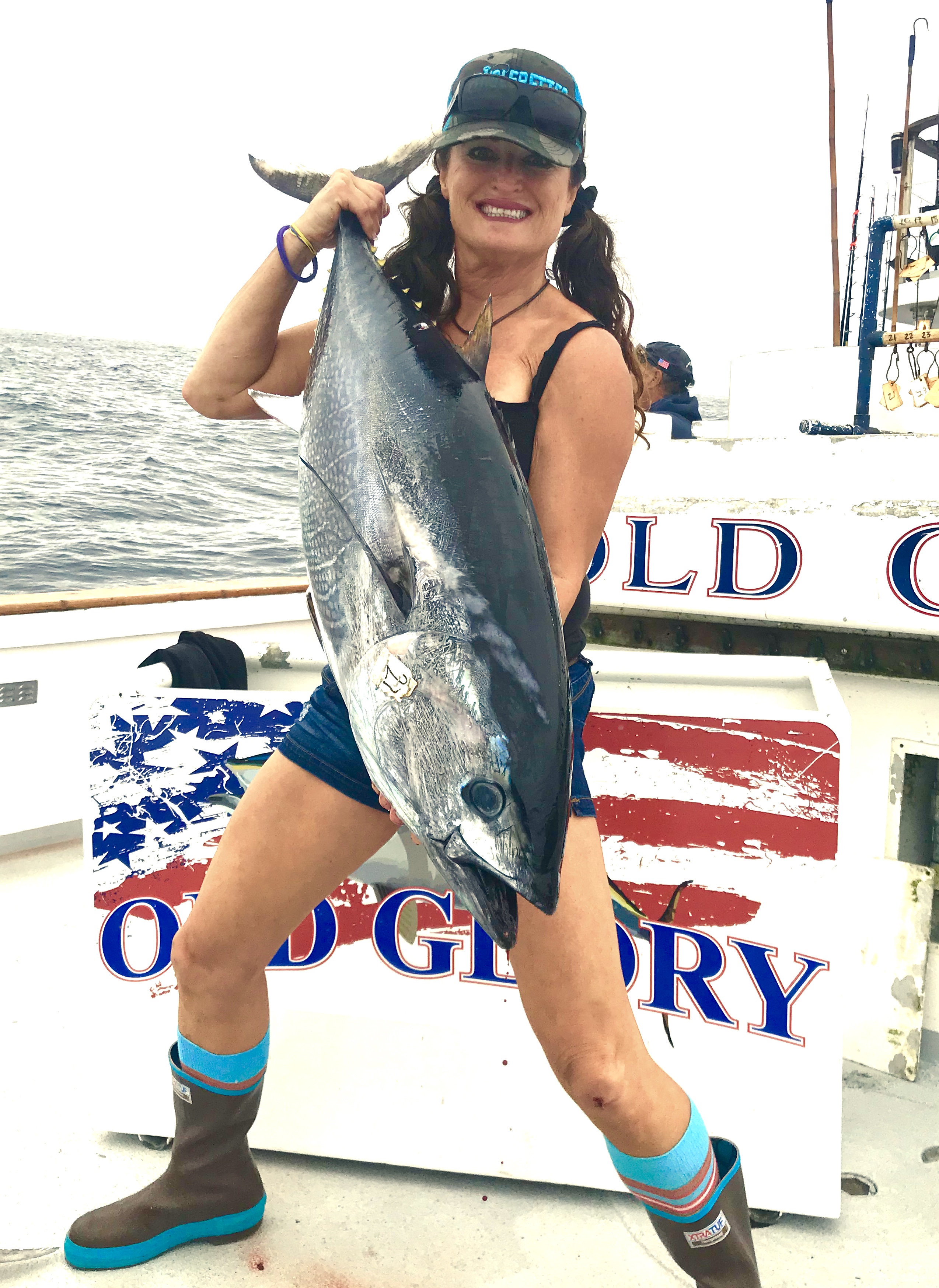
 Hey ladies do you love to fish? Or would you like to learn but you don’t know how to start? Maybe your friends don’t fish, you are new to the community or never tried fishing on a sportboat. Or you want to join your boyfriend or husband on the water but your not sure what to expect. If the idea of fishing on a boat full of strangers that are mostly men is intimidating to you then join the club. We have all been there. It can be like going to the movies or a bar by yourself -awkward!
Hey ladies do you love to fish? Or would you like to learn but you don’t know how to start? Maybe your friends don’t fish, you are new to the community or never tried fishing on a sportboat. Or you want to join your boyfriend or husband on the water but your not sure what to expect. If the idea of fishing on a boat full of strangers that are mostly men is intimidating to you then join the club. We have all been there. It can be like going to the movies or a bar by yourself -awkward!
This is a simple guide to help you learn some of the Do’s & Dont’s of Sportboat fishing from myself and other accomplishments lady anglers. I’ve been sportboat fishing for 5 years. Previous to that my fishing experience was limited to freshwater and saltwater fishing from small boats with family or friends. Quite different when compared to the large sportfishing boats out of San Diego.
My first trip on a sportfishing boat was on the Malihini out of H&M Landing. This boat was massive in comparison to what I was used to fishing on. It had a spacious galley with a chef, dining booths and bathrooms, unlike the coffee can that I was used to going in. I was excited but at the same time intimidated and scared. This boat was full of men with lots of rods & tackle and me with my one rod. I started to feel lost..all kinds of stuff was running through my head. Would I catch a fish? Would I know what to do? How would the men receive me being the only lady on the boat? Thank God for my fiancé who had some clue as to what to do, but it was still an unknown to me. As the boat set off I realized that just being out on the water was all I needed to help ease my fears. It was so beautiful and calming. On the way to the fishing grounds the crew gave a safety and fishing seminar to explain what types of fishing methods were working, explaining about following your line, proper baiting and basic reel operation. As we neared the bite zone the captain said throw bait! and all I remember after that was getting squeezed shoulder to shoulder between other anglers as they were getting bit all around me yelling happily and saying over! under! while scrambling along the rail bumping into me and others trying to let them pass. Combat fishing! I didn’t know what to do, and was frustrated wondering what had I got myself into. I learned later that this how you communicate with your fellow Anglers to avoid tangles and successfully land your fish.
Rule #1 Communicate with your fellow Anglers and follow your line. Your odds of getting a bite and landing your fish depend on it. Don’t panic. Everyone is working together, and the deckhands are there to assist if needed.
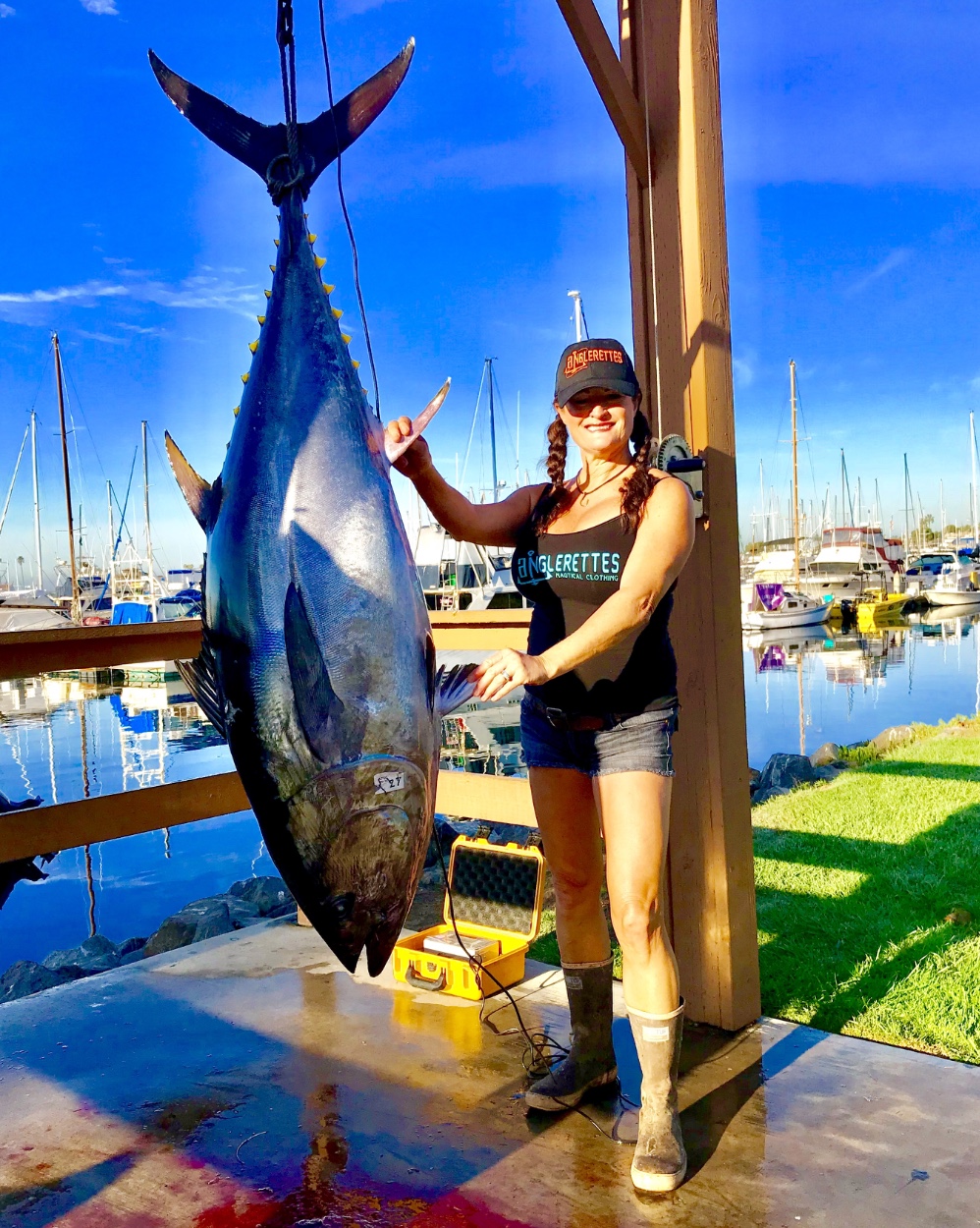 I let my frustration get the best of me and it hindered my ability to get bit. I got skunked and it was lesson learned. I was determined to catch a fish but I needed a new strategy, so on my next trip I spoke up like all the other Anglers did on the rail on my previous trip. I then decided that getting to know my fellow Anglers would benefit me – especially the ones that are hooking up & look like they know what they are doing. We are all a team at the rail.
I let my frustration get the best of me and it hindered my ability to get bit. I got skunked and it was lesson learned. I was determined to catch a fish but I needed a new strategy, so on my next trip I spoke up like all the other Anglers did on the rail on my previous trip. I then decided that getting to know my fellow Anglers would benefit me – especially the ones that are hooking up & look like they know what they are doing. We are all a team at the rail.
Rule #2 Get to know your fellow anglers. They are experienced and willing to help and share what they know as well as the crew on the boat.
I realized that I was also not asking enough questions so Rule #3 -Ask questions and Listen. You can never ask too many questions and learn the terminology of the boat: starboard, port, bow, etc. A great question to ask is what side of the boat should you fish on when the boat stops?- typically you want the wind in your face. Asking and learning equals success so learn and ask as much as you can.
Rule#4 Be polite to the Captains and crew as they want you to catch a fish this is their livelihood and they are very knowledgeable. Say please and thank you. If the bait well is empty and you need a bait say please, then thank you. This goes a long way with the crew. They work hard and deserve your respect. Last but not least,
Rule #5 Stay Positive. This will improve your success like that old Sesame Street Burt and Ernie episode with the two of them in a boat Burt was grouchy and in a bad mood as always and Ernie was relaxed positive and happy so when it came to catching fish all Ernie had to do was say “Here Fishy Fishy Fishy” and he caught fish. On the other hand Burt’s grouchy additude resulted in no fish! So be the Ernie not the Bert. Have a good time with a great additude. Relax it’s not as intimidating as it may seem. I enjoy all my fishing trips on sportboats now and I get excited and look forward to getting aboard, meeting new fellow anglers as well as old friends, swapping stories and just relaxing and fishing. Remember it’s fishing and catching is just the icing on the cake! The following pages are some well known excellent lady anglers and some pearls of wisdom from them
Tight Lines!
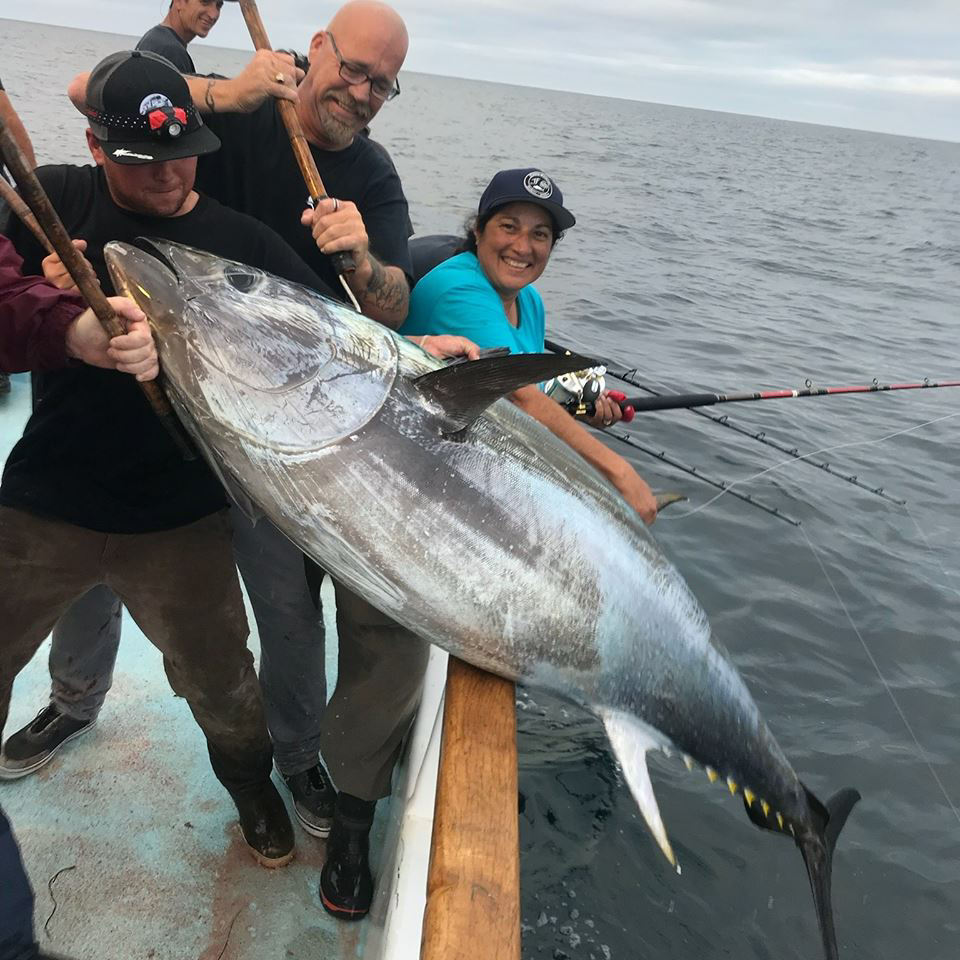 Theresa Sampson
Theresa Sampson
I have been fishing for over 35 years and have loved every moment. It doesn’t matter if I fish on the beach, on a lake or on a boat out on the ocean. I fish for what it gives me joy, peace and the excitement of challenge. My best advise has and always will be is to share the pure love of the sport, so don’t allow or be intimidated by anyone or anything, but when I am I just remind myself to have fun, learn and share what I can. In the end I find I’ve gained some friends and learned that my love for this sport gives me so much more than I had imagined and I get to take home some fish!
 Janette Fuson
Janette Fuson
The first time I stepped on the boat I had no idea what I was doing when it came to deep sea fishing. There was many seasoned anglers and deckhands that are always willing to help with their knowledge and answer every question I had . That made me feel very comfortable. The time went by so quickly because of endless conversation between us all I couldn’t believe how much I learned the first day! And still to this day I’m always learning something every time I go out.. who would have known that my first feelings of being shy on the boat would have turned out to be quiet the opposite.. I love fishing and go out as much as I can. It has turned into my passion.
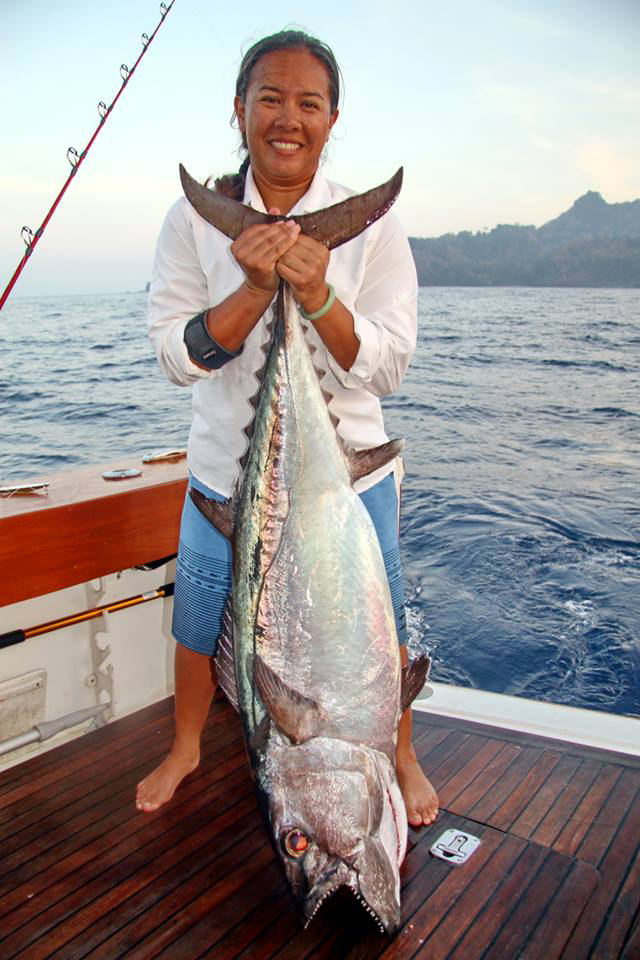 Sophia Huynh
Sophia Huynh
As a lady angler be confident in the skills you have and things you know but if you are unsure JUST ASK FOR HELP! Don’t let your insecurities stop you from having a good time. Everyone is nervous the first time they go on a fishing trip. That trip may be on a new boat or fishing for a new species or going by themselves. As one of my favorite captains told me “You have to get your mind right to get your line tight” This applies in so many ways. If you get frustrated take a moment to reset, if you seem not to be getting bit then ask what is working, don’t doubt yourself and have fun!!
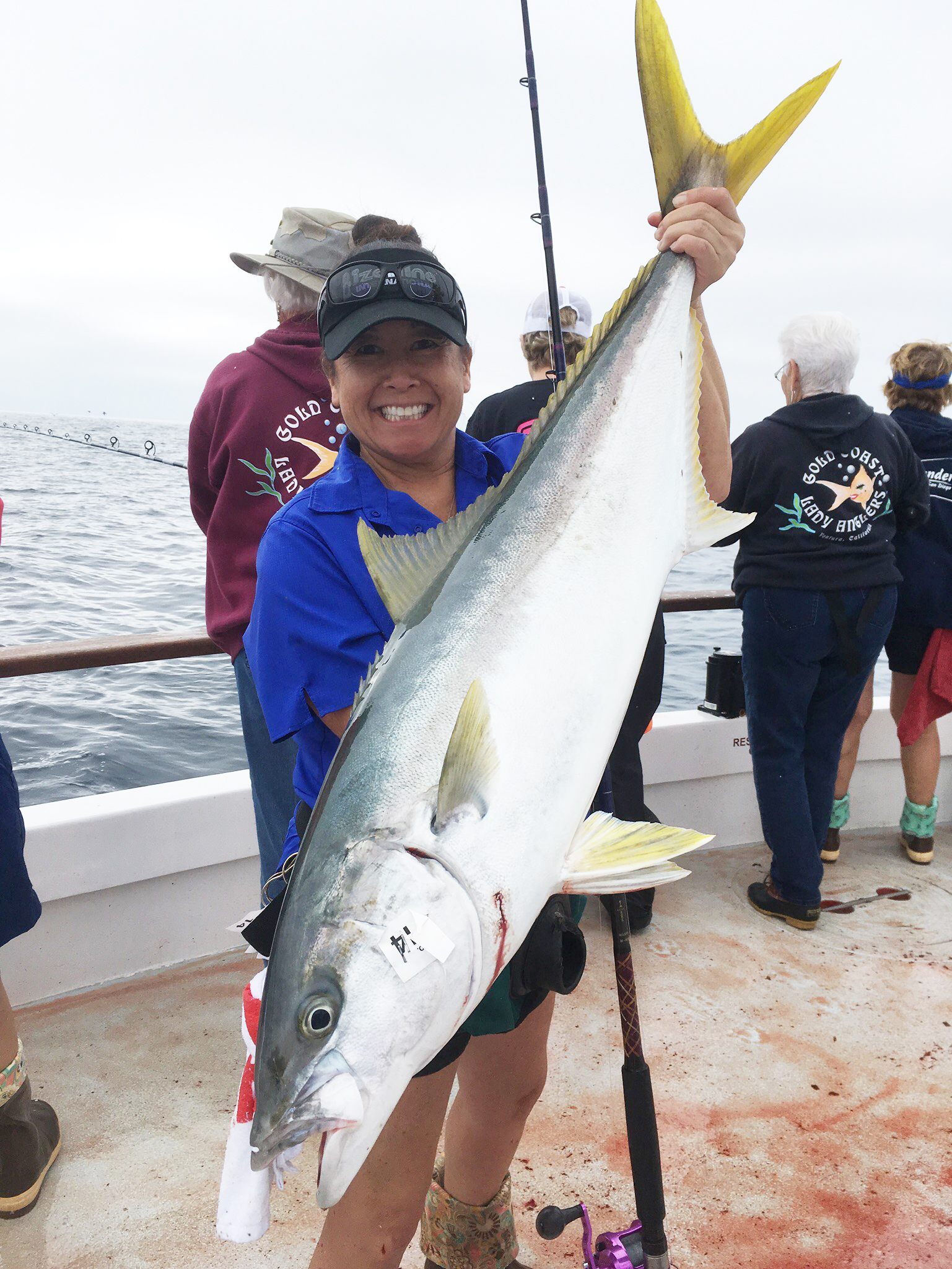
Wendy Tochihara
My advice: Do your homework and figure out what fish you will be targeting. Learn how to tie your own fishing knots and listen to the Captain and crew if you are fishing on a charter boat. The Captain and crew are on the water everyday, they are in the know, listen to them.
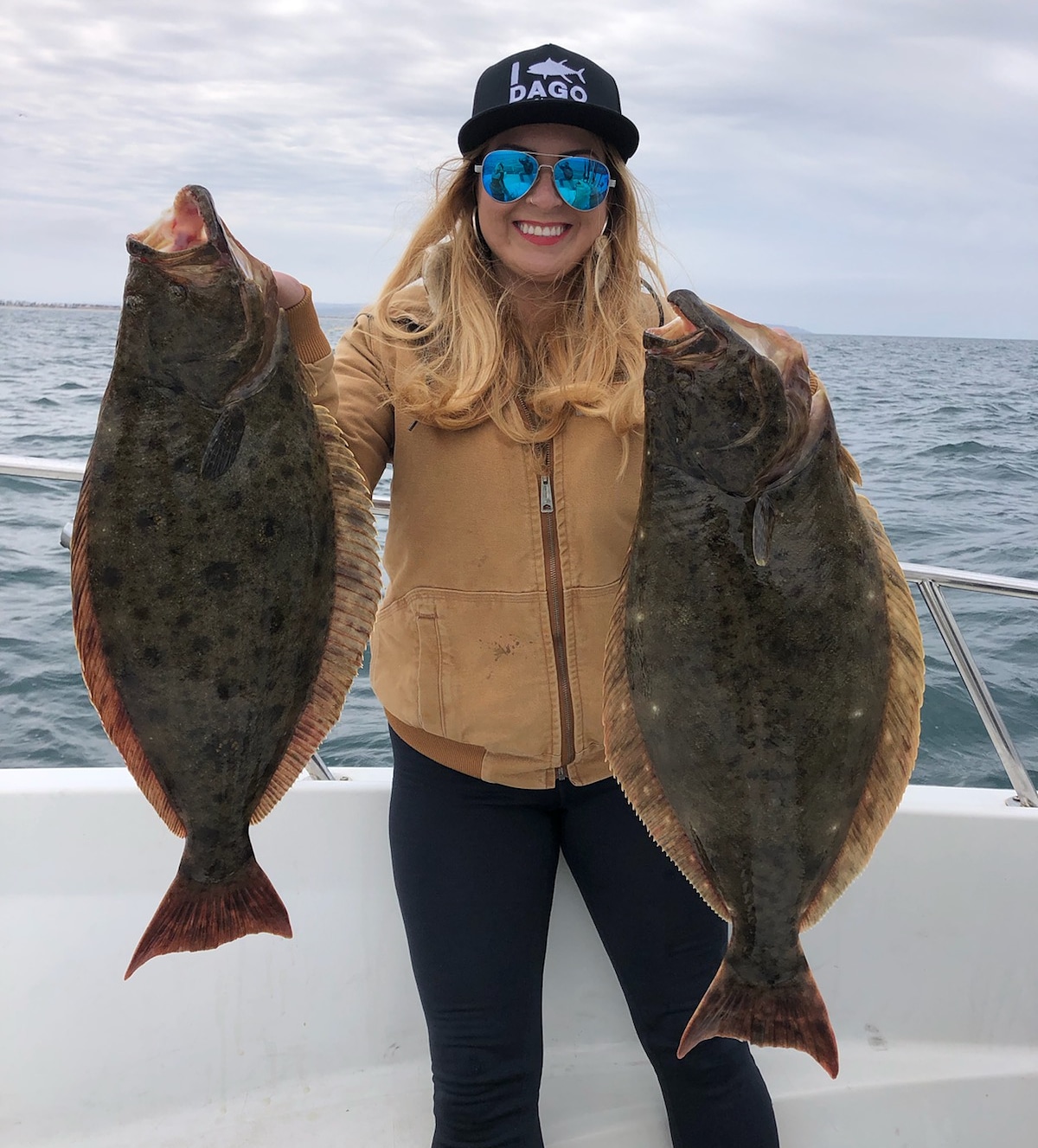 Jessica Cano
Jessica Cano
Always stay humble. Just remember every time you go out it’s a new learning experience. And most importantly have fun!
Some additional tips to get you started on your fishing adventure are below.
#1 Planning your fishing Trip: Booking your trip there are several types of trips available depending on how long you would like to fish…1/2 day, 3/4 day *(May require a passport), Overnight, 1.5 and Long-range.
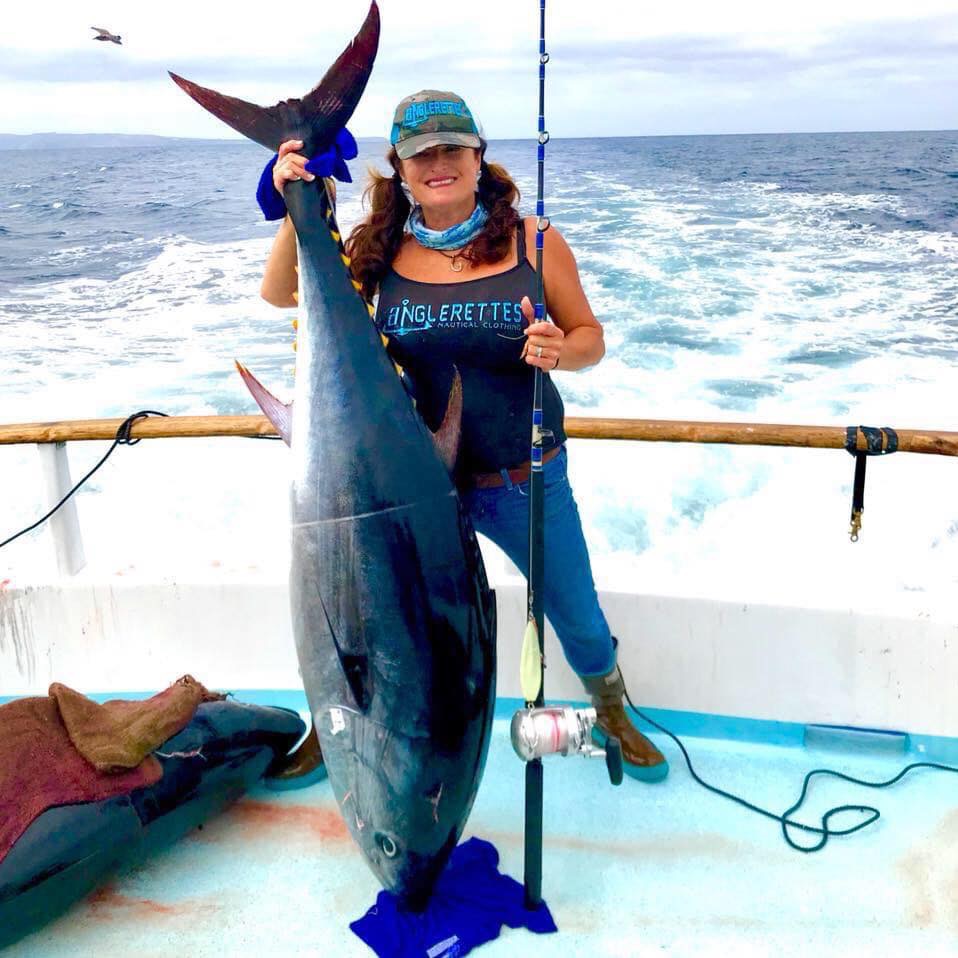 #2 Learn your knots. YouTube is you best friend when learning new knots. The deckhands can help you with tying your knots as well but when it get busy you can feel confident that you can do it with these 2 easy knots plus men are impressed when a lady can tie her own hooks and leaders. *The Palomar Knot: One of the strongest knots & quick to tie to a hook or jig *The Royal Polaris other wise known as the “RP” Knot it’s my go to for tying Spectra which is braided line to leader. *A Leader Consists if either Monofilament or Fluorocarbon (a less visible leader when the bite is sensitive)
#2 Learn your knots. YouTube is you best friend when learning new knots. The deckhands can help you with tying your knots as well but when it get busy you can feel confident that you can do it with these 2 easy knots plus men are impressed when a lady can tie her own hooks and leaders. *The Palomar Knot: One of the strongest knots & quick to tie to a hook or jig *The Royal Polaris other wise known as the “RP” Knot it’s my go to for tying Spectra which is braided line to leader. *A Leader Consists if either Monofilament or Fluorocarbon (a less visible leader when the bite is sensitive)
#3 Call the Landing the night before to confirm your trip. They sometimes get canceled due to weather.
#4 The night before eat a light meal if your not sure if you get sea sick there is nothing is worse then feeling sick on a boat. There are various over the counter and prescription medications you can buy so check with your pharmacist or doctor to see what will help for you. I bring ginger chews for passengers that might get a little queasy. It helps to calm the stomach.
#5 Dress appropriately. Wearing layers is great so you can remove layers if the weather warms up. Buy a pair of rubber boots or shoes so your feet won’t get wet when the deckhands wash down the decks during your trip. The crews are constantly cleaning the boat to make it safe and comfortable for you. Bring a hat, glasses, pliers, sunscreen, ID/passport, tackle rod & reels, * if you don’t have your own gear the Landing will assist you with the proper rod & reel to rent along with hooks and weight. Remember to bring cash. The boats don’t take credit cards and you will need cash for your galley & fish cleaning bill and lastly please remember to tip your crew. They work hard long hours to make your fishing trip a pleasant and fun experience.
I hope this advice convinces you to give sportfishing a try. It’s fun, exciting and you just might catch a big one!

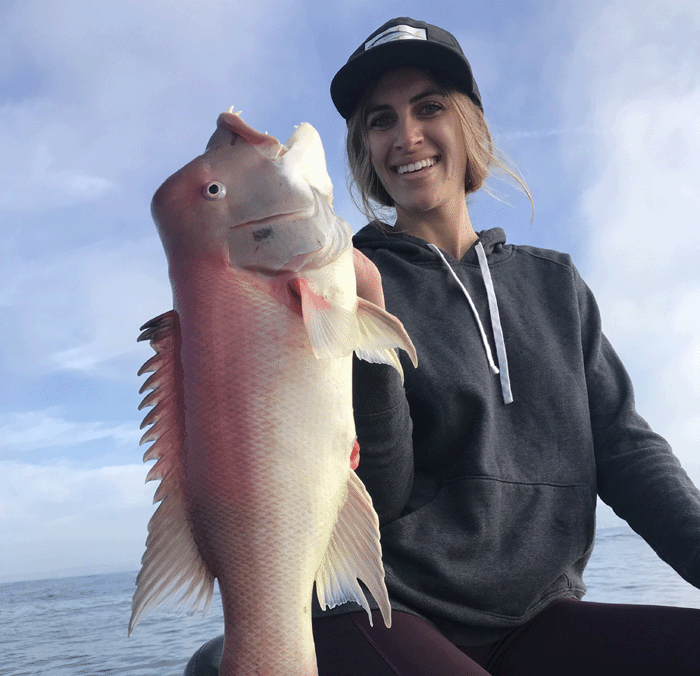
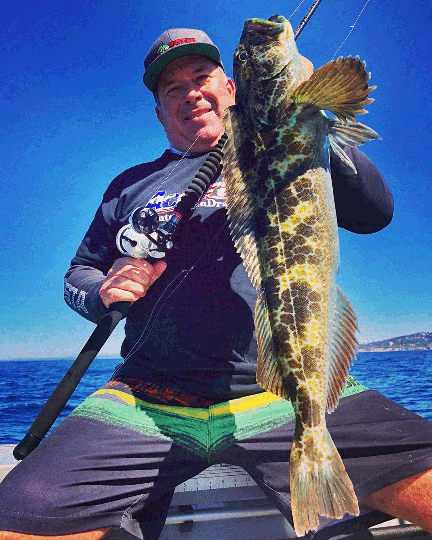 The past few years have seen a spawn of new fishing opportunities on the west coast with the influx of both bluefin and yellowfin tuna here almost year-round. The focus on these other species has taken pressure off of other species including rockfish.
The past few years have seen a spawn of new fishing opportunities on the west coast with the influx of both bluefin and yellowfin tuna here almost year-round. The focus on these other species has taken pressure off of other species including rockfish.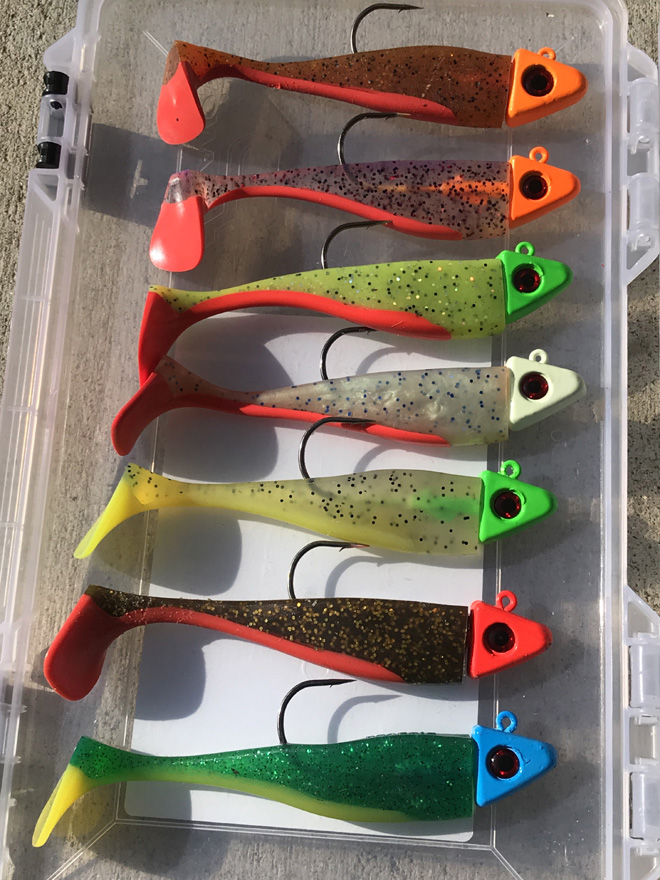 All the reels mentioned above come in a two gear ratios, a power and speed ratio. The higher or mid range gear ratios are more effective so you can get your lures back from the depths quicker. The other important feature to look at is a counter balanced power handle. Its way more comfortable and easier to wind, giving you more torque to wind when bringing up a big red.
All the reels mentioned above come in a two gear ratios, a power and speed ratio. The higher or mid range gear ratios are more effective so you can get your lures back from the depths quicker. The other important feature to look at is a counter balanced power handle. Its way more comfortable and easier to wind, giving you more torque to wind when bringing up a big red.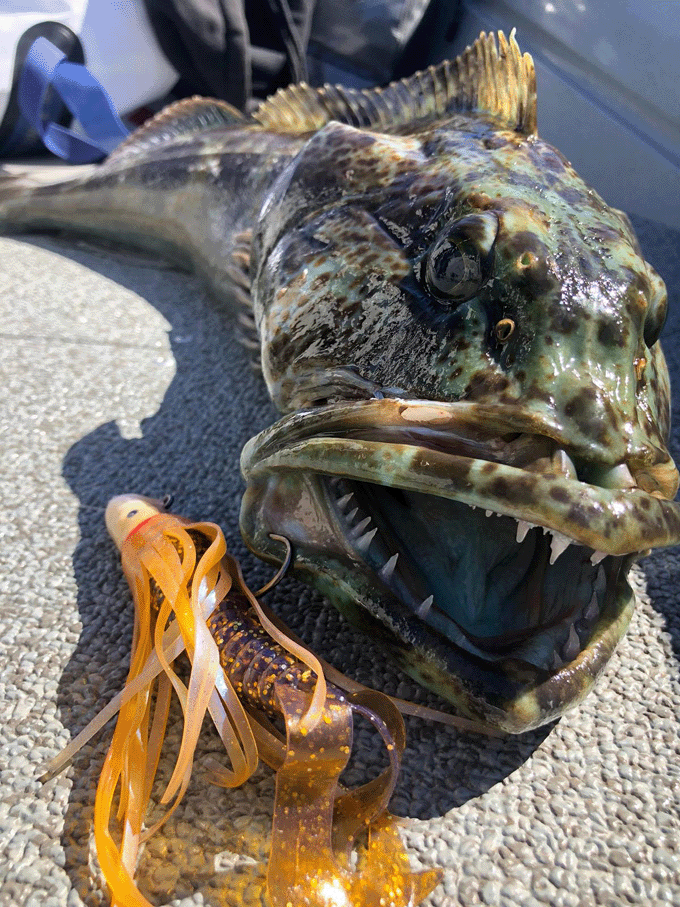 Artificial lures: There are a lot of artificial lures to choose from but here are a few to consider for rock fishing.
Artificial lures: There are a lot of artificial lures to choose from but here are a few to consider for rock fishing.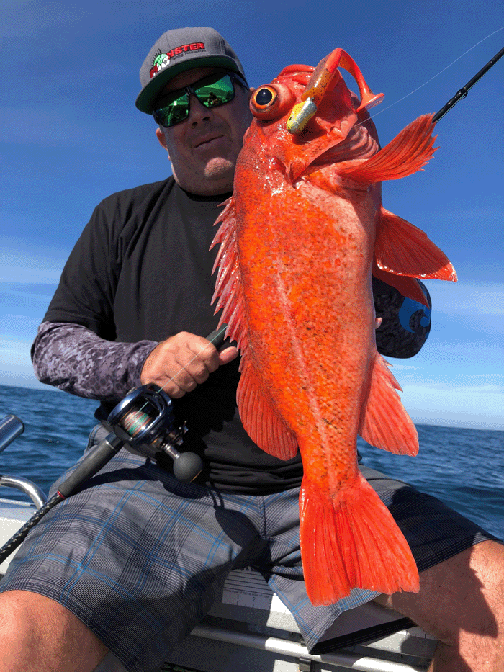 Optimum lures have been in the fishing business for many years developing a variety of swim bait lures. They have recently focused on the Optimum Magnum Pus in 5” and 7” sizes that work extremely well on a jighead or as a metal jig trailer. (Optimumbaits.com)
Optimum lures have been in the fishing business for many years developing a variety of swim bait lures. They have recently focused on the Optimum Magnum Pus in 5” and 7” sizes that work extremely well on a jighead or as a metal jig trailer. (Optimumbaits.com)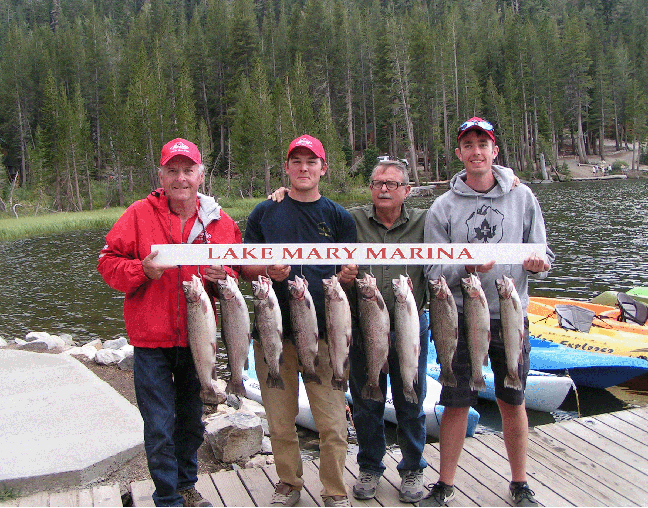
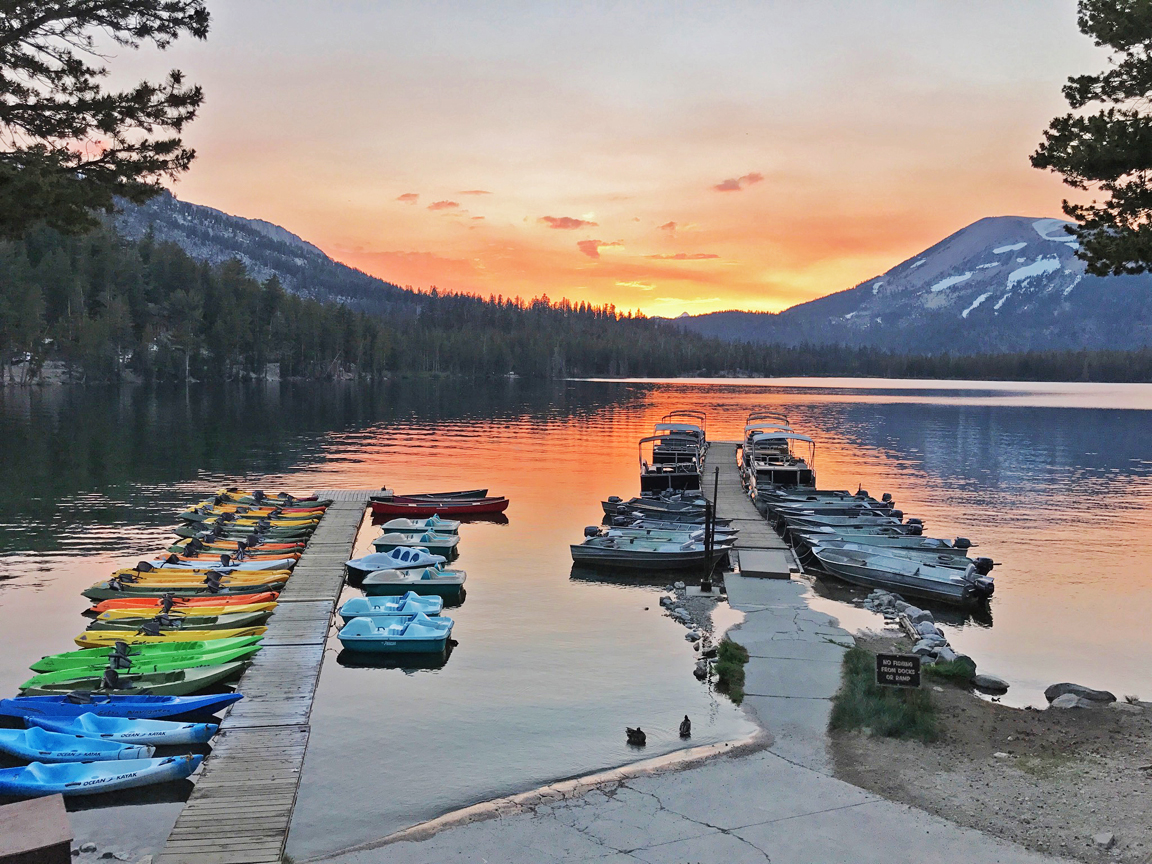 I love the Eastern Sierra. Some of the nicest scenery on the planet fills your senses just driving up the 395 highway. There are countless lakes in the Sierra to fish. The choices are narrowed down considerably when I think about lakes that have big hungry trout and easy access for fishing. Having fished the Sierra for many years and I have found that certain lakes are a par above the rest when it comes to giving me the opportunity to just drive up to a lake, unload my gear and attempt to catch the big one. Lake Mary in the Mammoth Lake basin is one of my favorites. Almost the entire lake is shore accessible. There’s lots of elbow room at this lake and if your legs aren’t up to the task of walking then consider they have a first class marina with every type of floating vessel for you to rent, ranging from kayaks, pedal boats, pontoon boats and regular aluminum v-hull boats.
I love the Eastern Sierra. Some of the nicest scenery on the planet fills your senses just driving up the 395 highway. There are countless lakes in the Sierra to fish. The choices are narrowed down considerably when I think about lakes that have big hungry trout and easy access for fishing. Having fished the Sierra for many years and I have found that certain lakes are a par above the rest when it comes to giving me the opportunity to just drive up to a lake, unload my gear and attempt to catch the big one. Lake Mary in the Mammoth Lake basin is one of my favorites. Almost the entire lake is shore accessible. There’s lots of elbow room at this lake and if your legs aren’t up to the task of walking then consider they have a first class marina with every type of floating vessel for you to rent, ranging from kayaks, pedal boats, pontoon boats and regular aluminum v-hull boats.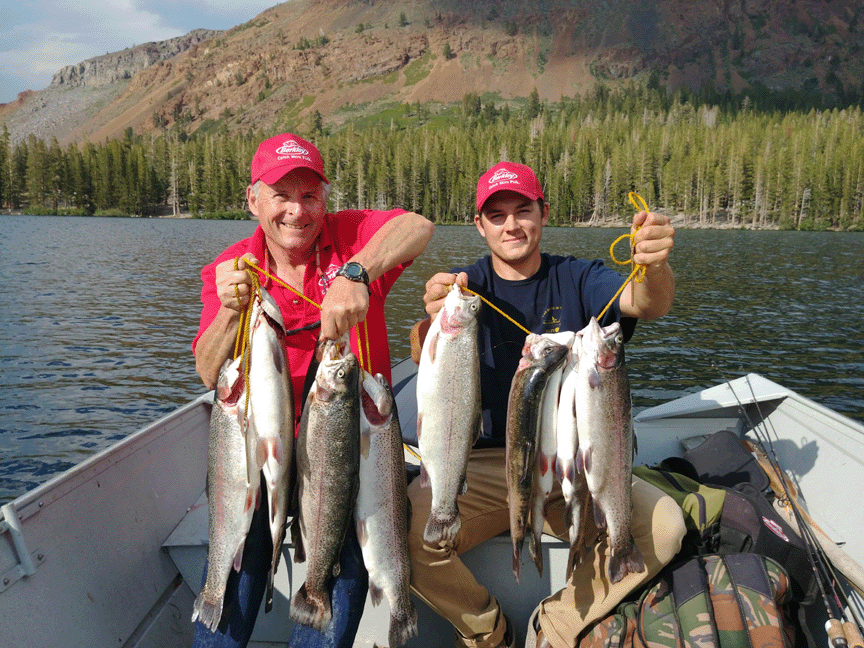 It’s a mythical fish that only a few have encountered and no photos have been shown to bear witness to its size. Maybe they should rename him the Locke Mary Beastie. But if Don says he’s out there then I’m a believer. There is also a population of brook trout and there are a few cutthroats along with some Dolly Vardens that have previously been planted years ago according to Don.
It’s a mythical fish that only a few have encountered and no photos have been shown to bear witness to its size. Maybe they should rename him the Locke Mary Beastie. But if Don says he’s out there then I’m a believer. There is also a population of brook trout and there are a few cutthroats along with some Dolly Vardens that have previously been planted years ago according to Don.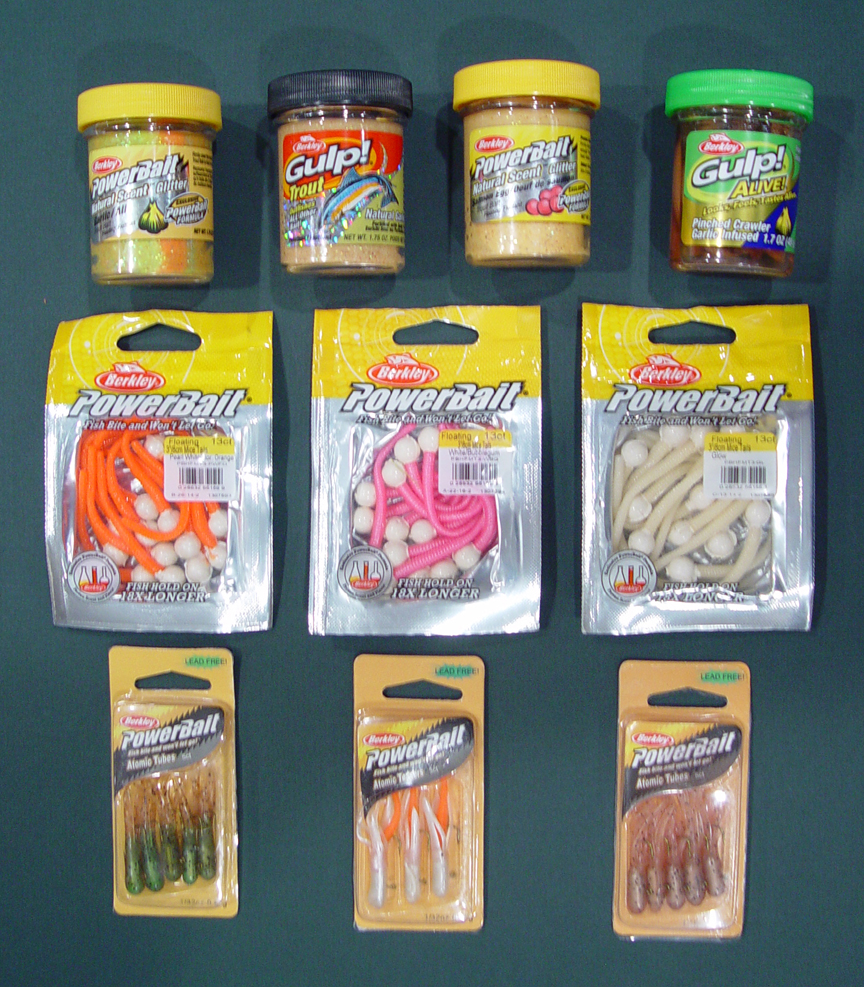 One of the top lures that consistently produces trophy trout in the Sierra is the mini tube jig. Marlon Meade Berkley pro team member recommends using the Berkley Atomic Teasers at these lakes. His top choices for colors are the Pearl White and the Cricket clear brown. It just plain works and changing up the colors keeps the action nonstop. For me, I like to use the Berkley Mice Tails with the smallest of split shots wrapped 2-3 feet from the Mice Tail on a # 8 or smaller Owner fly hook, so it drifts down slowly and moves with the current. The more popular colors to use are Pearl White head with Fluro Orange worm tail, Pearl White head with Bubblegum Pink tail and Glow White head and tail. Berkley Mice Tails have just been so darn successful for catching fish up there and is now my “go to” lure of choice. They can be rigged any number of ways by using a Carolina rig, split shot, or drop shot. Depending on the weather conditions will dictate what method to use.
One of the top lures that consistently produces trophy trout in the Sierra is the mini tube jig. Marlon Meade Berkley pro team member recommends using the Berkley Atomic Teasers at these lakes. His top choices for colors are the Pearl White and the Cricket clear brown. It just plain works and changing up the colors keeps the action nonstop. For me, I like to use the Berkley Mice Tails with the smallest of split shots wrapped 2-3 feet from the Mice Tail on a # 8 or smaller Owner fly hook, so it drifts down slowly and moves with the current. The more popular colors to use are Pearl White head with Fluro Orange worm tail, Pearl White head with Bubblegum Pink tail and Glow White head and tail. Berkley Mice Tails have just been so darn successful for catching fish up there and is now my “go to” lure of choice. They can be rigged any number of ways by using a Carolina rig, split shot, or drop shot. Depending on the weather conditions will dictate what method to use.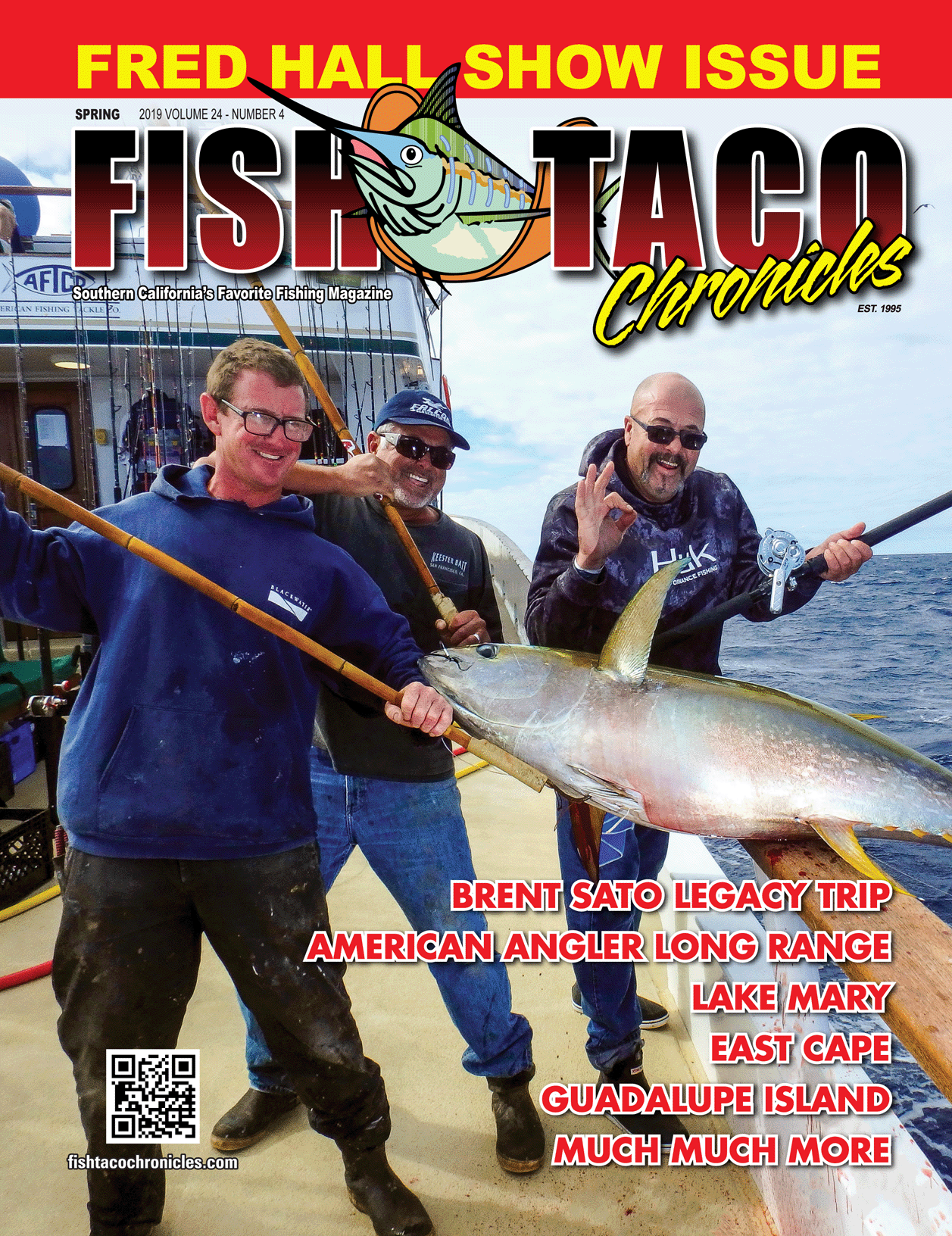
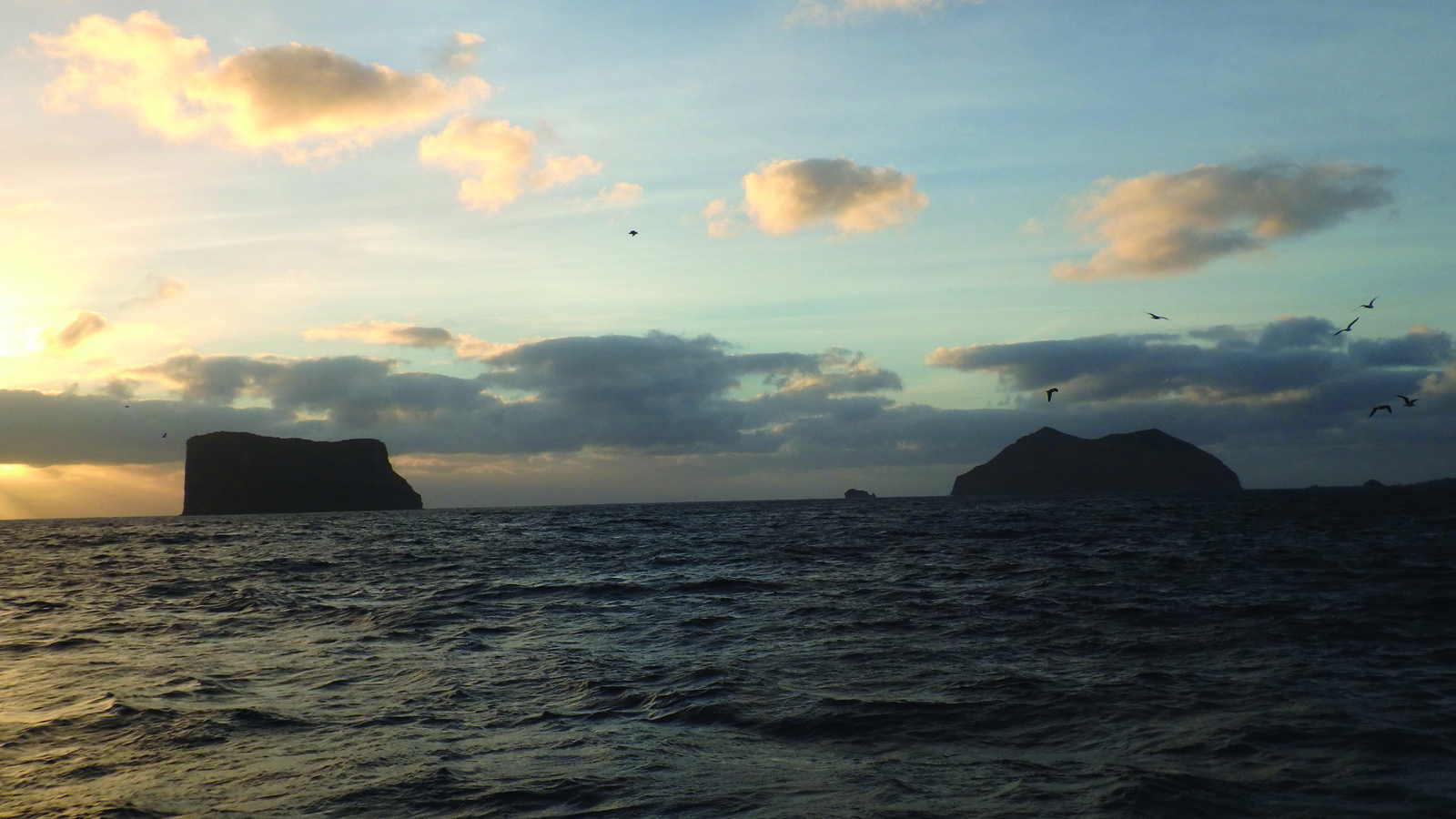

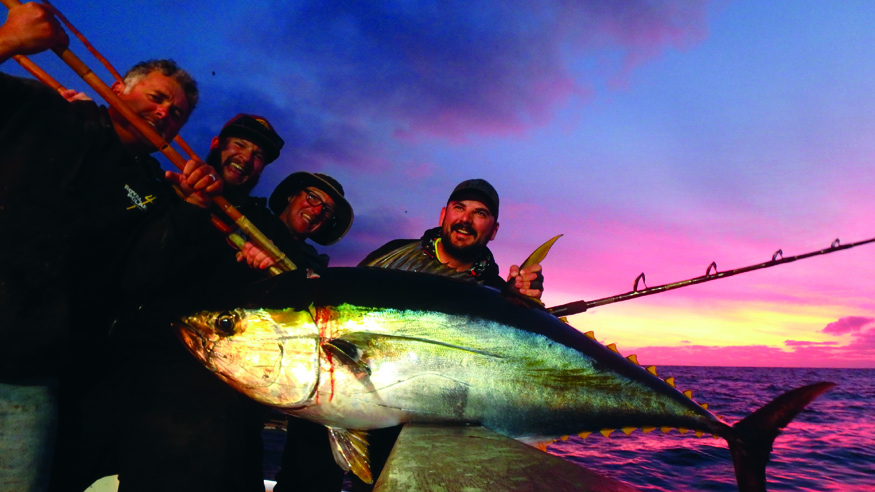
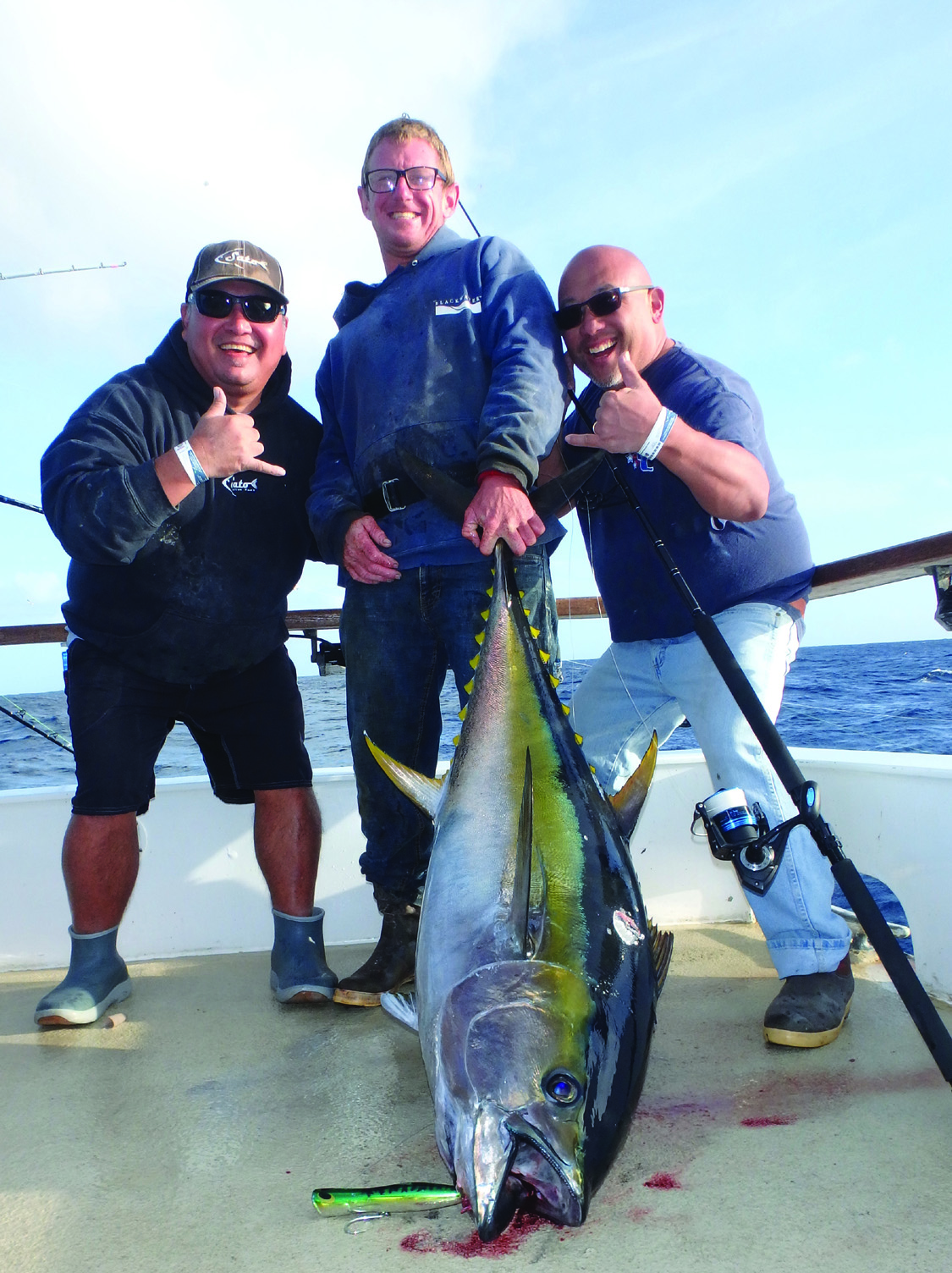
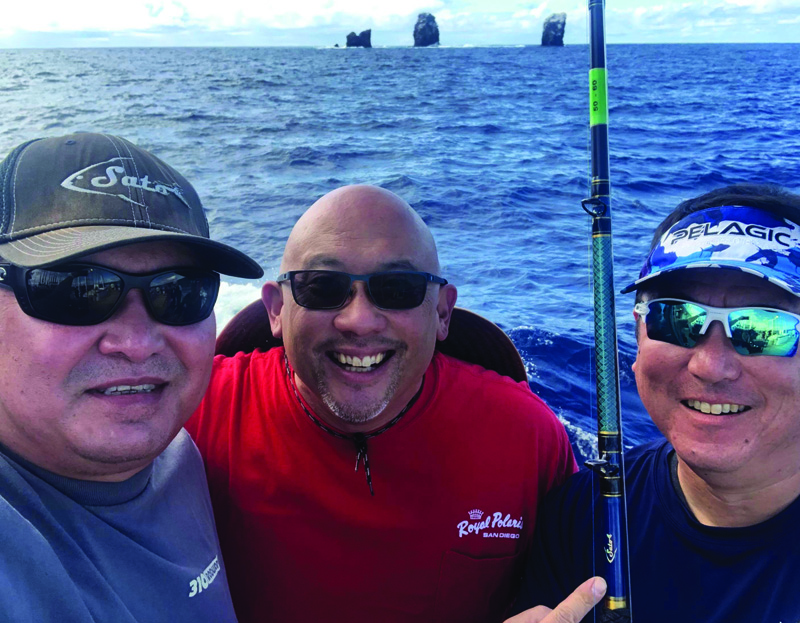 With the Wahoo under our belt, with strings of the tasty cabrilla in the well and with just enough yellowtail to leave us wanting more, the decision was made to cut and run. We started a 30-hour slow chugging ride uphill to the famed Guadalupe Island. The “Lupe” was in our future and we were ready, or so we thought.
With the Wahoo under our belt, with strings of the tasty cabrilla in the well and with just enough yellowtail to leave us wanting more, the decision was made to cut and run. We started a 30-hour slow chugging ride uphill to the famed Guadalupe Island. The “Lupe” was in our future and we were ready, or so we thought.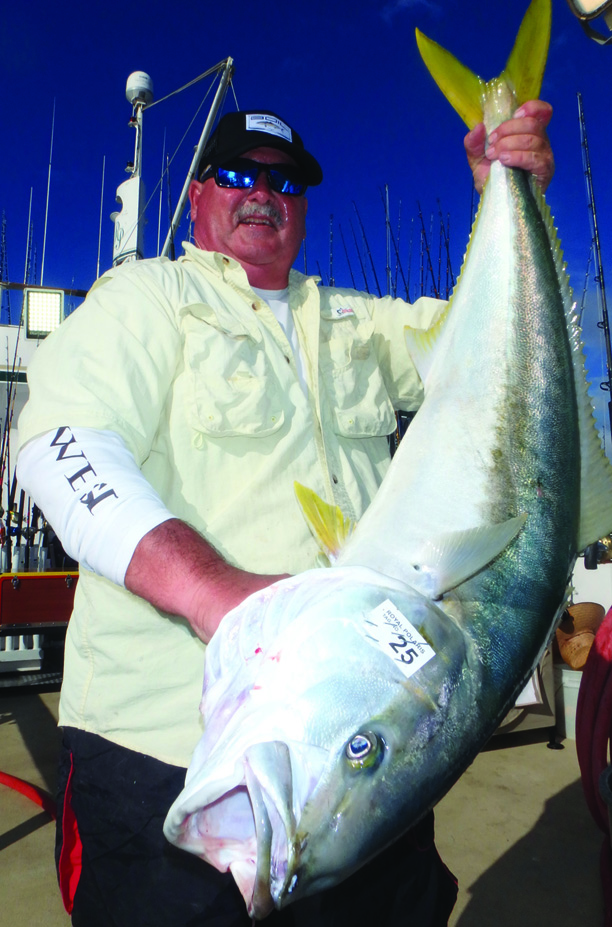
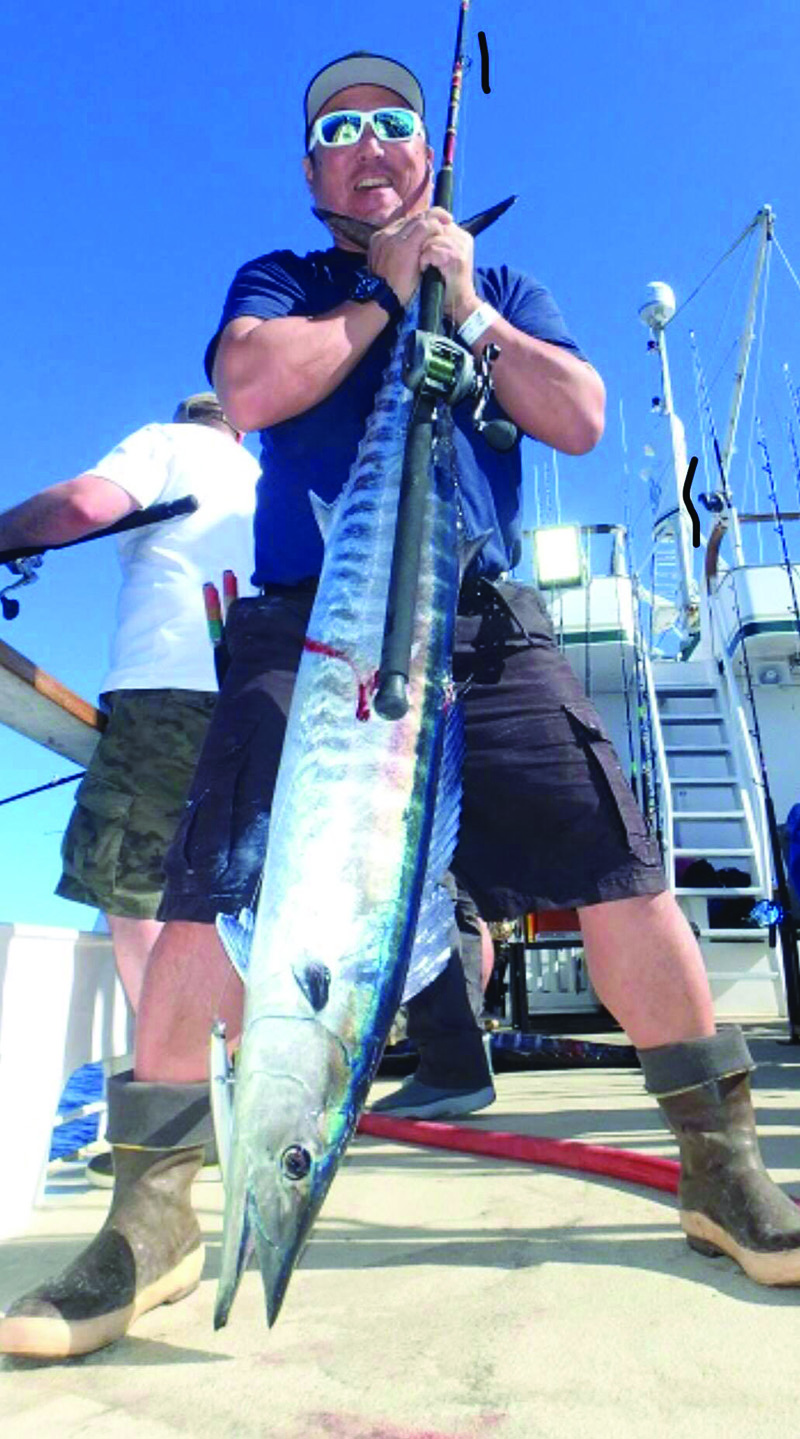 When we arrived at the Island, Capt. Roy Rose said it was going to be “breezy”. I thought to myself “breezy”?? I’ve never heard Roy use that term before. We arrived around 3am and woke up to a stiff 25-30 knots morning wind, only to increase to about 35-40 knots by mid-afternoon. The fish were biting though and all of sudden we didn’t care about the wind any more. We had a steady pick on the 60-80lb stock class, with a few stand out 100+ pound fish.
When we arrived at the Island, Capt. Roy Rose said it was going to be “breezy”. I thought to myself “breezy”?? I’ve never heard Roy use that term before. We arrived around 3am and woke up to a stiff 25-30 knots morning wind, only to increase to about 35-40 knots by mid-afternoon. The fish were biting though and all of sudden we didn’t care about the wind any more. We had a steady pick on the 60-80lb stock class, with a few stand out 100+ pound fish.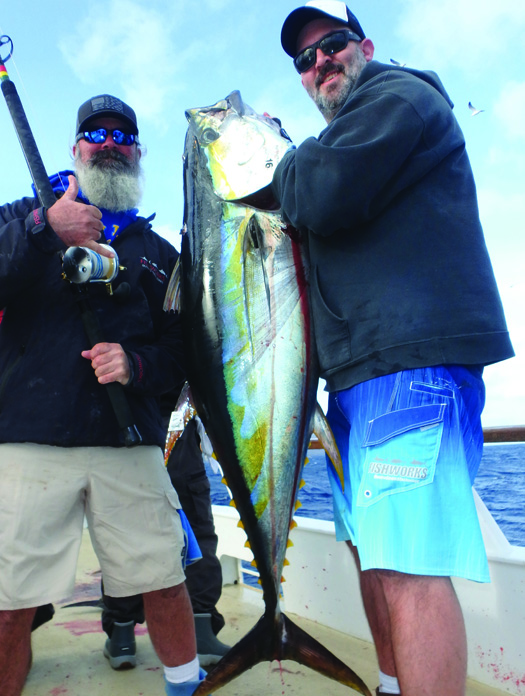
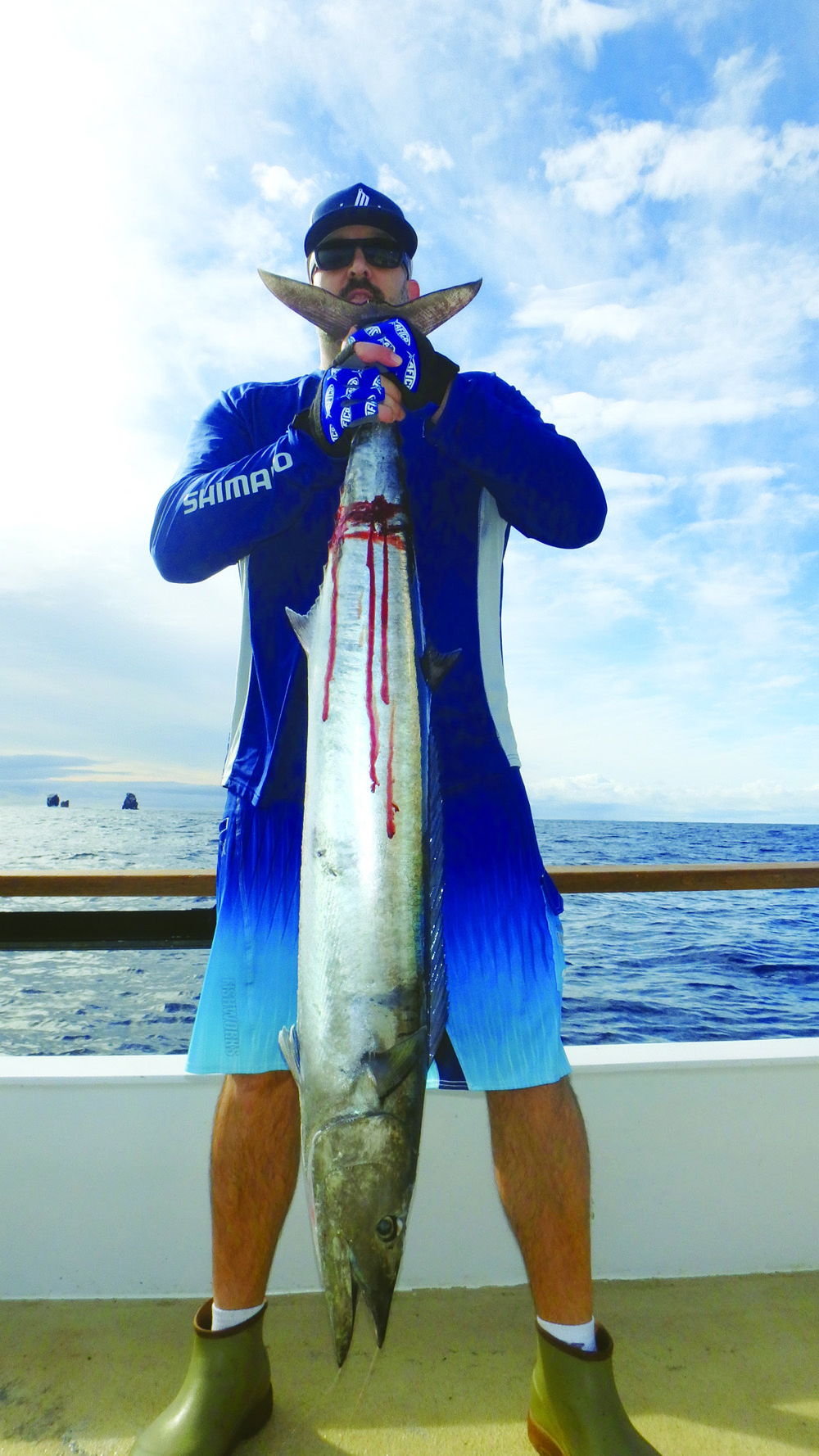
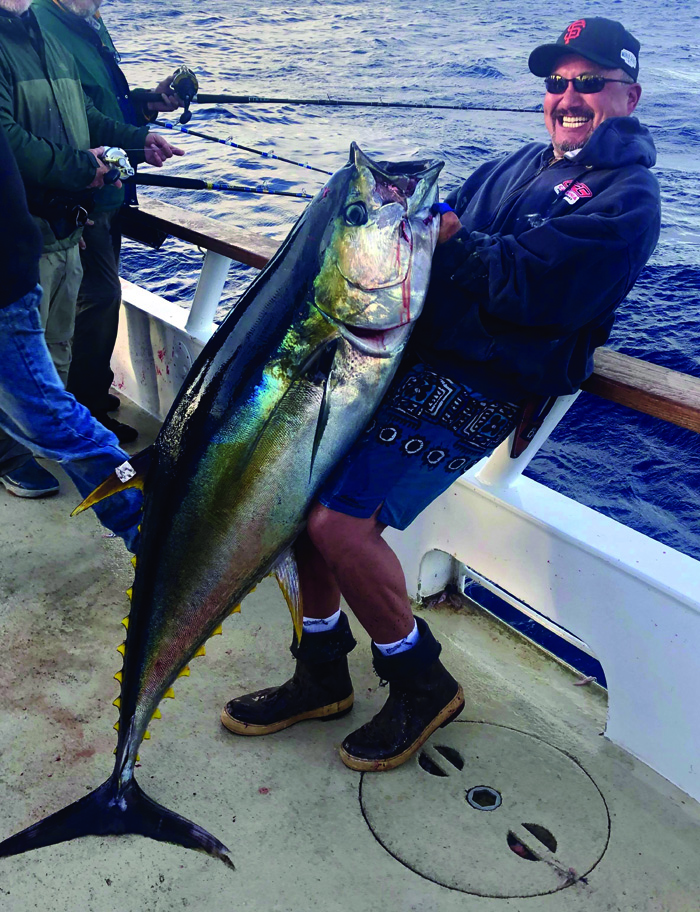 The next battle that Vic faced was the second day of the trip as Roy was beginning to hunt down the right spot of fish. Things had slowed to a dull roar. Fish were being hooked but if you know Roy, you know he wasn’t about to sit idly by waiting. He was going to find the group of fish that were ready to play. As Roy was charging on a line of fish that were up and chasing bait, he made the fateful call out to the group, “If you’ve got a popper or surface plug get it out there…they’re coming!” Little did Roy know, but Vic just had a new popping rod built for this trip. Strapped to a custom US80 tilefish was a Daiwa Saltist 6500 spooled up with 80lb braid with a short 100lb leader tied to it. The popper flew out off the starboard stern corner. With a huge splash it hit the water. Just as it did, Roy threw the throttles forward and the boat took off! Line was flying off the spool! As the bail was tripped and the line came tight, the phenomenon of line stripping off the reel was met with a quizzical face. As Roy pulled the throttles back and the boat out of gear, Vic looked at the rod…looked at the reel…looked at the line and with all of that input into his brain, he still couldn’t really tell what was going on. The rod was bent…but not really. The line was tight but no longer stripping off the spool. Pump after pump the line made it back on to the spool. Slowly but surely, he was making headway. With all eyes on him, Vic heard from the peanut gallery, “Looks like you got a Mackerel there!” A few more minutes pass and low and behold…the line starts ripping off the spool and the real fight was on. After another long fight, with adrenalin masking the fatigue, Darin asked Vic if he needed a hand. Darin grabbed the rod as Vic’s hands began to shake. As Vic made his way inside to get some fluids into his system, Darin went to work to move the fish within range to bring it aboard. Pump by pump. Crank by crank. The gaff slid in. The celebration began. A 100lb tuna found its way aboard the Royal Polaris for the brother of the man we were paying homage to on this trip.
The next battle that Vic faced was the second day of the trip as Roy was beginning to hunt down the right spot of fish. Things had slowed to a dull roar. Fish were being hooked but if you know Roy, you know he wasn’t about to sit idly by waiting. He was going to find the group of fish that were ready to play. As Roy was charging on a line of fish that were up and chasing bait, he made the fateful call out to the group, “If you’ve got a popper or surface plug get it out there…they’re coming!” Little did Roy know, but Vic just had a new popping rod built for this trip. Strapped to a custom US80 tilefish was a Daiwa Saltist 6500 spooled up with 80lb braid with a short 100lb leader tied to it. The popper flew out off the starboard stern corner. With a huge splash it hit the water. Just as it did, Roy threw the throttles forward and the boat took off! Line was flying off the spool! As the bail was tripped and the line came tight, the phenomenon of line stripping off the reel was met with a quizzical face. As Roy pulled the throttles back and the boat out of gear, Vic looked at the rod…looked at the reel…looked at the line and with all of that input into his brain, he still couldn’t really tell what was going on. The rod was bent…but not really. The line was tight but no longer stripping off the spool. Pump after pump the line made it back on to the spool. Slowly but surely, he was making headway. With all eyes on him, Vic heard from the peanut gallery, “Looks like you got a Mackerel there!” A few more minutes pass and low and behold…the line starts ripping off the spool and the real fight was on. After another long fight, with adrenalin masking the fatigue, Darin asked Vic if he needed a hand. Darin grabbed the rod as Vic’s hands began to shake. As Vic made his way inside to get some fluids into his system, Darin went to work to move the fish within range to bring it aboard. Pump by pump. Crank by crank. The gaff slid in. The celebration began. A 100lb tuna found its way aboard the Royal Polaris for the brother of the man we were paying homage to on this trip.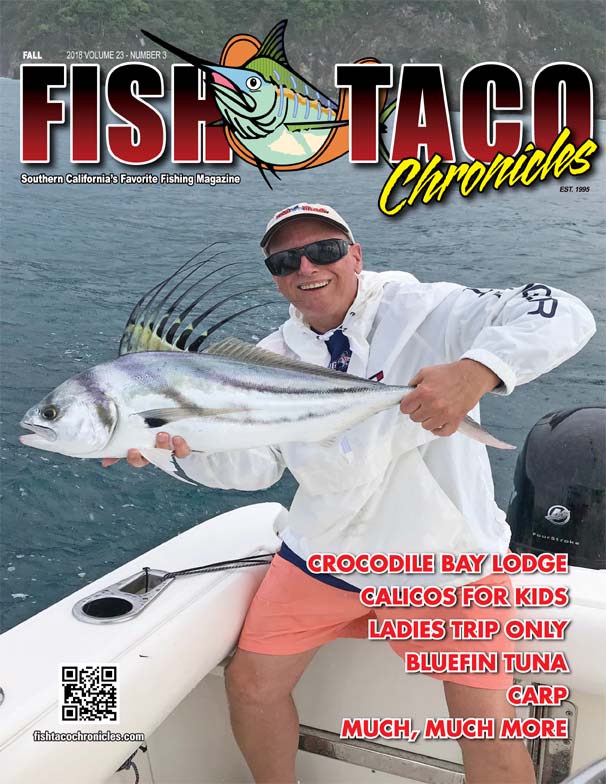

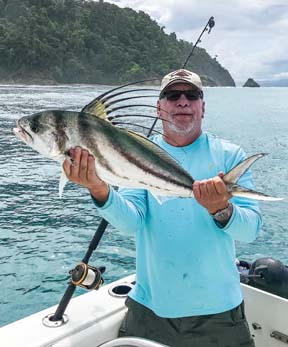
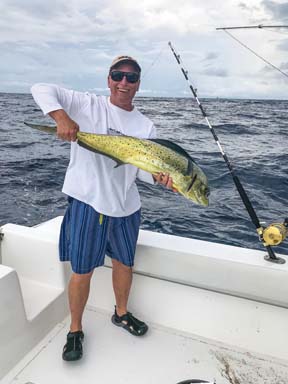 All the equipment on the boat worked great. They had excellent rods and reels and they were boasting the PENN brand and name. We were catching our small dorado and tuna on little Senator reels, but the marlin was caught on a new PENN International reel.
All the equipment on the boat worked great. They had excellent rods and reels and they were boasting the PENN brand and name. We were catching our small dorado and tuna on little Senator reels, but the marlin was caught on a new PENN International reel.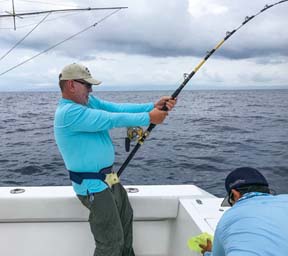
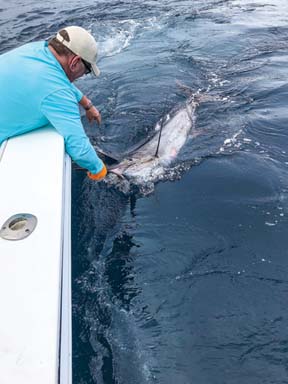
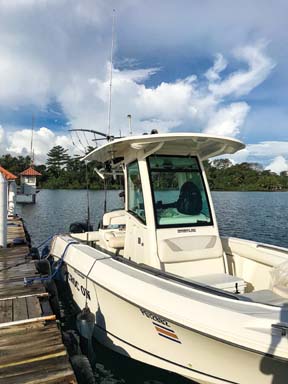 their 600- foot pier. I did not fish on the pier, but I was tempted. I was told that there were big pargo down there, but I was so busy doing other things I did not have the time to try it.
their 600- foot pier. I did not fish on the pier, but I was tempted. I was told that there were big pargo down there, but I was so busy doing other things I did not have the time to try it. On day three which was our last full day there, Joe and I were booked to go inshore fishing and try for roosterfish.
On day three which was our last full day there, Joe and I were booked to go inshore fishing and try for roosterfish.  We were on a smaller 25’ Whaler since we were going inshore. It was a beautiful and comfortable boat. The weather looked like it could be nasty as there were many clouds and just had the feeling of rain. Once we got on the water and were out for 10 minutes we could see rain all over the water but for some reason it was leaving us alone. It was all around us like we had a cone over us. Not 30 minutes from the dock at Crocodile Bay Resort we started trolling live bait about 200 yards off the coast for roosterfish. After about a half hour of this with no bites I grabbed a spinning reel with a popper and gave that a try. It took about an hour into our fishing but a roosterfish (the one on the cover) finally got fooled on the troll and I quickly jumped up and went to battle with the 15-20 pound or so roosterfish. When I was here 18 years ago I caught one over 50 pounds and can still remember what a great fight that was. This guy for his size was quite feisty and did not want to come in but after about 5 minutes I got him to the boat. After a couple of photos that Joe should be proud of the rooster was carefully released.
We were on a smaller 25’ Whaler since we were going inshore. It was a beautiful and comfortable boat. The weather looked like it could be nasty as there were many clouds and just had the feeling of rain. Once we got on the water and were out for 10 minutes we could see rain all over the water but for some reason it was leaving us alone. It was all around us like we had a cone over us. Not 30 minutes from the dock at Crocodile Bay Resort we started trolling live bait about 200 yards off the coast for roosterfish. After about a half hour of this with no bites I grabbed a spinning reel with a popper and gave that a try. It took about an hour into our fishing but a roosterfish (the one on the cover) finally got fooled on the troll and I quickly jumped up and went to battle with the 15-20 pound or so roosterfish. When I was here 18 years ago I caught one over 50 pounds and can still remember what a great fight that was. This guy for his size was quite feisty and did not want to come in but after about 5 minutes I got him to the boat. After a couple of photos that Joe should be proud of the rooster was carefully released.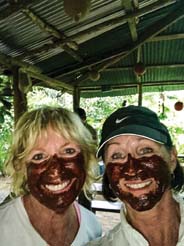
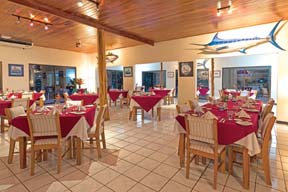

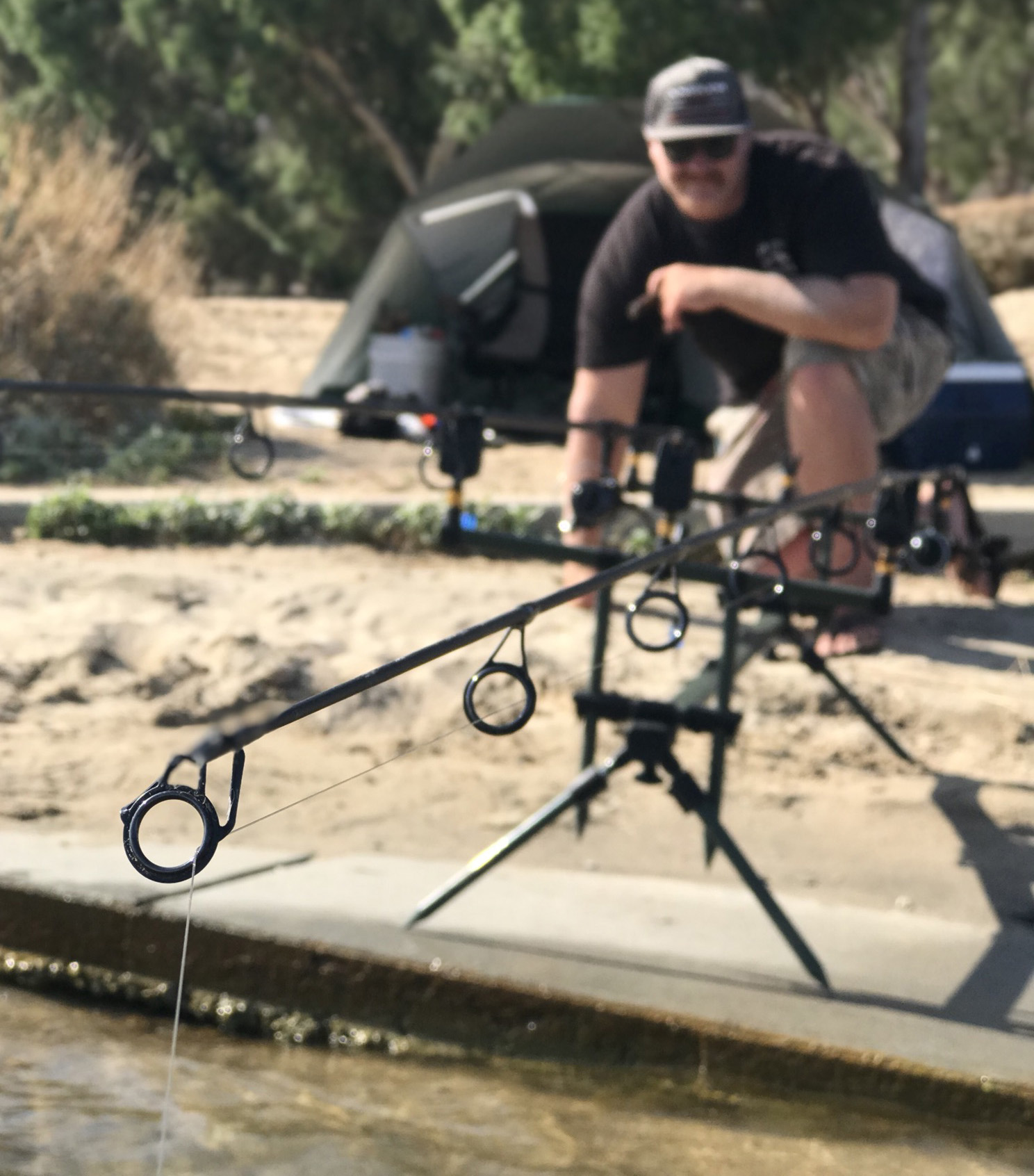 Having been born in Ukraine, I grew up hearing about the joys of carp fishing from my grandpa, my dad and their friends who still practice their traditional methods here on the lakes of southern California. However, I wanted to hear more about the modern techniques, directly from the anglers pursuing these monster carp under the radar locally. I recently linked up with David Smith, an avid carp angler from the UK, who is now living in Riverside county and his buddy Patrick, a life long Californian fisherman who’s recently fallen in love with these new angling techniques and thrill of carp fishing. Interestingly, David is an owner of a bait company by the name of CarpPro, that supplies this growing group of enthusiasts with some of the products necessary to catch one of these monsters. I’ll touch more on that later!
Having been born in Ukraine, I grew up hearing about the joys of carp fishing from my grandpa, my dad and their friends who still practice their traditional methods here on the lakes of southern California. However, I wanted to hear more about the modern techniques, directly from the anglers pursuing these monster carp under the radar locally. I recently linked up with David Smith, an avid carp angler from the UK, who is now living in Riverside county and his buddy Patrick, a life long Californian fisherman who’s recently fallen in love with these new angling techniques and thrill of carp fishing. Interestingly, David is an owner of a bait company by the name of CarpPro, that supplies this growing group of enthusiasts with some of the products necessary to catch one of these monsters. I’ll touch more on that later!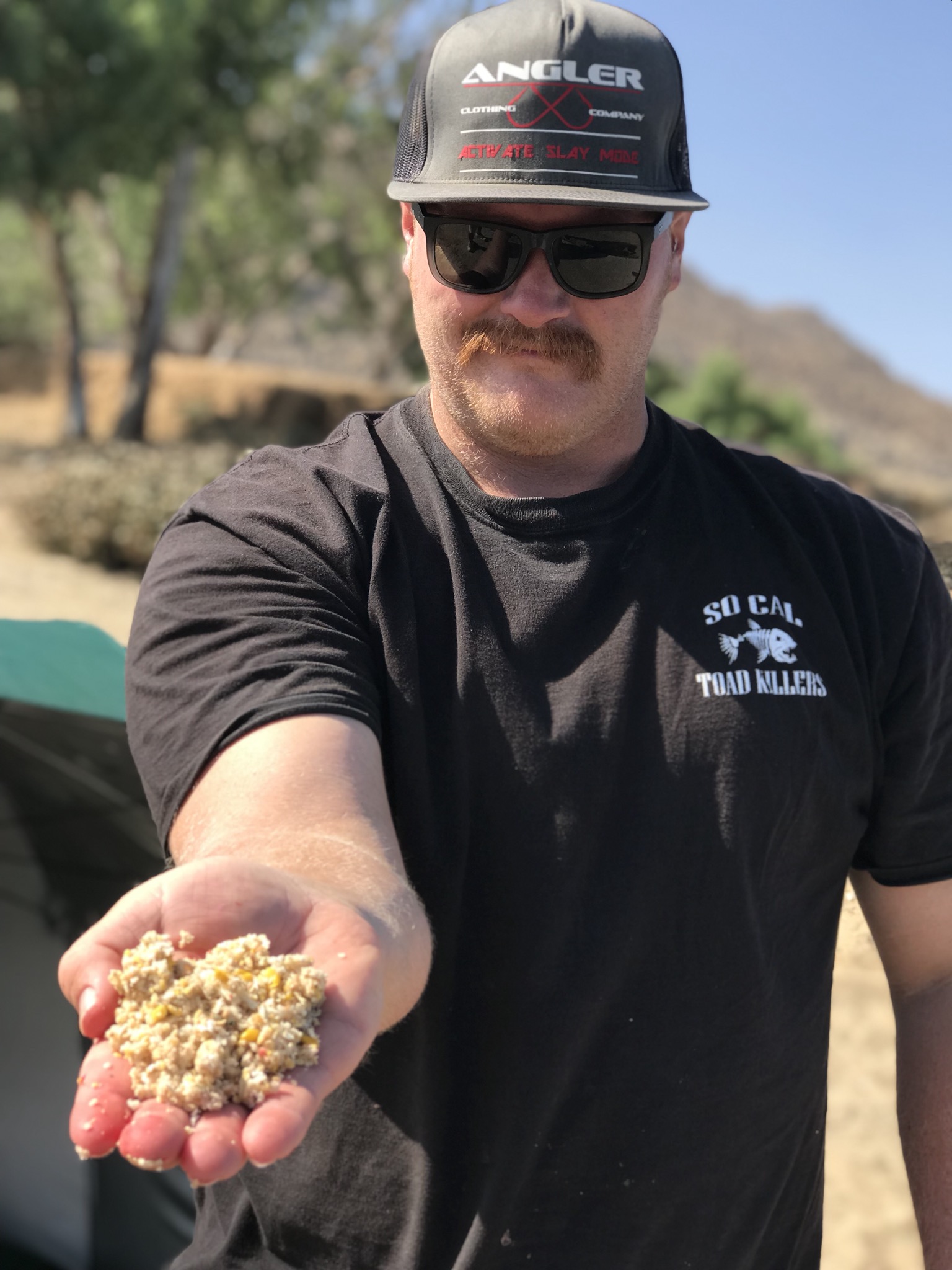 The guys had decided on one of the many local waters that are known to contain a healthy population of carp for our session. Immediately, I’m struck by the tackle these guys are using. Long 12ft rods and large surf casting reels are standard issue to propel large dough balls the many yards necessary to reach the fish. “Being bank anglers, you a need a rod that has the ability to cast a heavy bait ball to the fish, which sometimes means over a distance of 100+ yards,” explained David. “Carp often tell you where they are by jumping and rolling, something that should never be ignored. Nothings more infuriating than seeing a fish and not being able to get to him!” he said. I watched him cast a float and sinker combo that allowed him to determine the depth and nature of the bottom, at a spot where leaping fish had been seen. “We’re attempting to understand what’s down at the bottom so we know how to present a bait and use the line clip on the reel to cast to the same spot every time by carefully determining the range” added David. Developing a “spot” is key to successful carp angling the guys told me, especially here in California where chumming to create a feeding zone isn’t allowed.
The guys had decided on one of the many local waters that are known to contain a healthy population of carp for our session. Immediately, I’m struck by the tackle these guys are using. Long 12ft rods and large surf casting reels are standard issue to propel large dough balls the many yards necessary to reach the fish. “Being bank anglers, you a need a rod that has the ability to cast a heavy bait ball to the fish, which sometimes means over a distance of 100+ yards,” explained David. “Carp often tell you where they are by jumping and rolling, something that should never be ignored. Nothings more infuriating than seeing a fish and not being able to get to him!” he said. I watched him cast a float and sinker combo that allowed him to determine the depth and nature of the bottom, at a spot where leaping fish had been seen. “We’re attempting to understand what’s down at the bottom so we know how to present a bait and use the line clip on the reel to cast to the same spot every time by carefully determining the range” added David. Developing a “spot” is key to successful carp angling the guys told me, especially here in California where chumming to create a feeding zone isn’t allowed.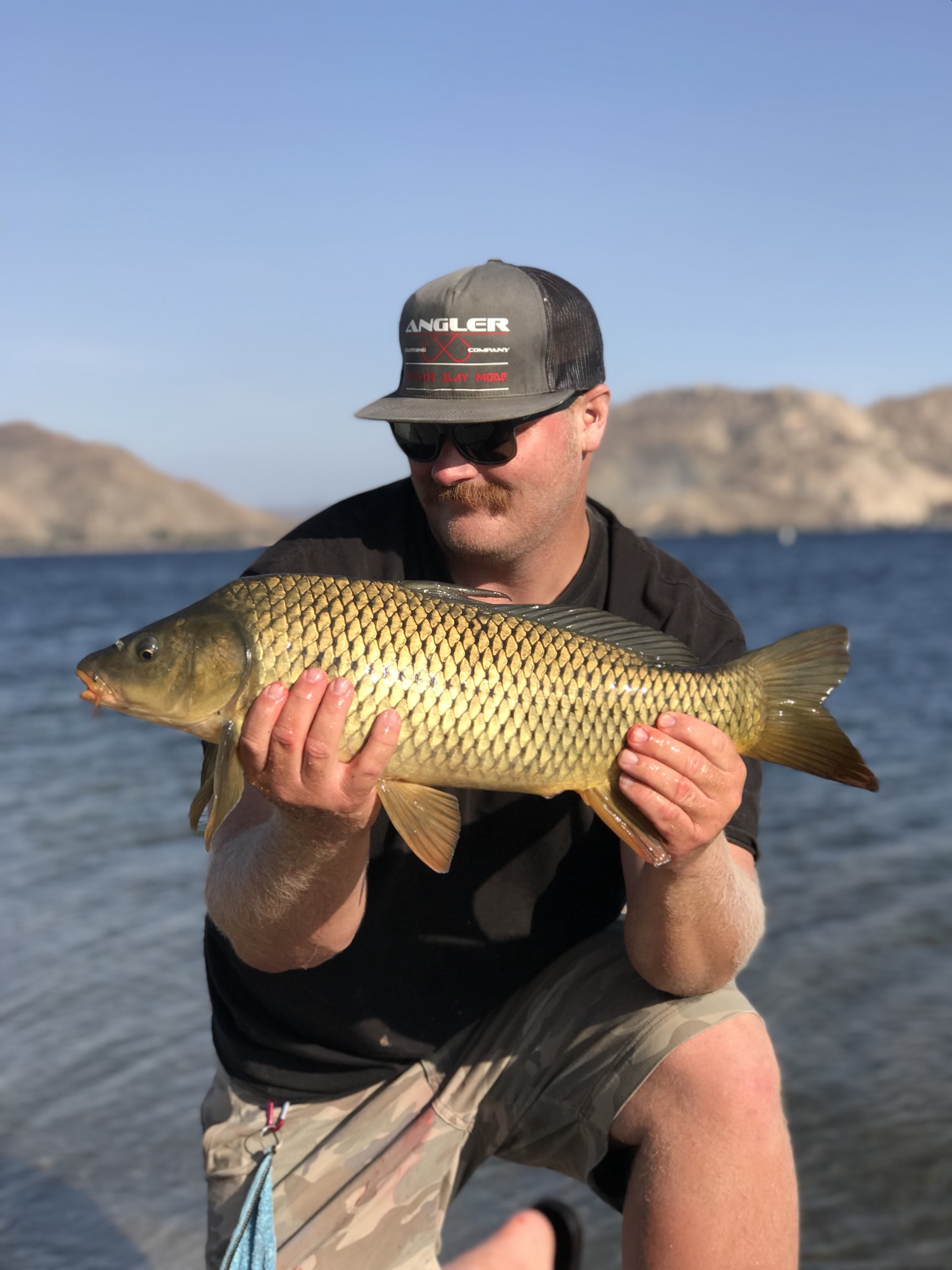 Now that they have established their spot, we’ll move on to the bait and hooking arrangements. Like many traditional carp angling techniques, things are focused largely on the way carp feed by sucking up and blowing around as they vacuum up food from the lake or river bed.
Now that they have established their spot, we’ll move on to the bait and hooking arrangements. Like many traditional carp angling techniques, things are focused largely on the way carp feed by sucking up and blowing around as they vacuum up food from the lake or river bed.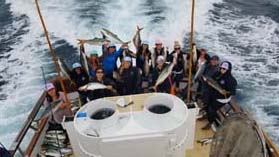
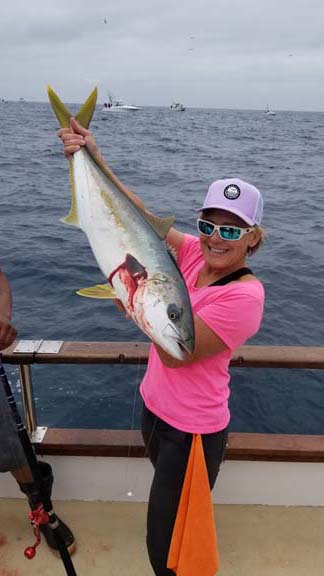 Before we even got on the boat, the Tuna War participants from the Tomahawk and Tribute, were getting back from their trip and were at the landing. Of course, we had to have pictures taken with the Wicked Tuna stars, Captain Dave Marciano and Captain Paul Hebert. This only created more excitement.
Before we even got on the boat, the Tuna War participants from the Tomahawk and Tribute, were getting back from their trip and were at the landing. Of course, we had to have pictures taken with the Wicked Tuna stars, Captain Dave Marciano and Captain Paul Hebert. This only created more excitement.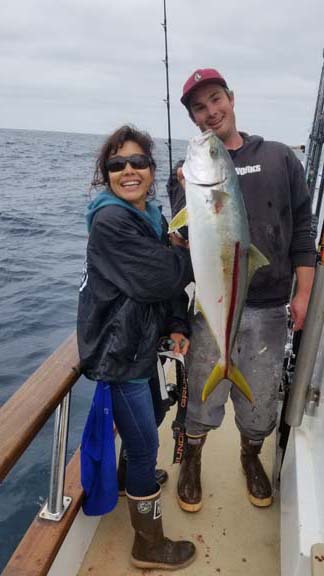
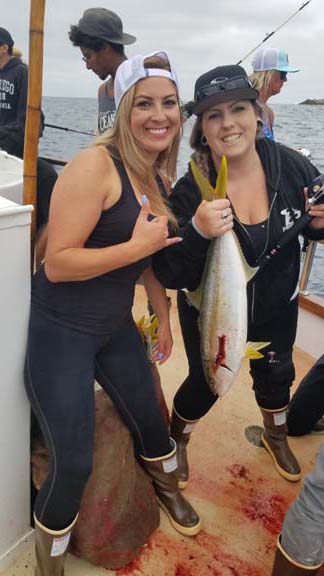 Our adventure was to be an overnight on The Voyager with Captain Todd Myers at the helm. Todd and his crew, RJ and Chuck, were about to experience what many crews don’t get to. Fifteen lovely ladies who are biting at the bit to get out on the water and catch some fish. All of our tackle was ready to go and our first stop was to get bait.
Our adventure was to be an overnight on The Voyager with Captain Todd Myers at the helm. Todd and his crew, RJ and Chuck, were about to experience what many crews don’t get to. Fifteen lovely ladies who are biting at the bit to get out on the water and catch some fish. All of our tackle was ready to go and our first stop was to get bait.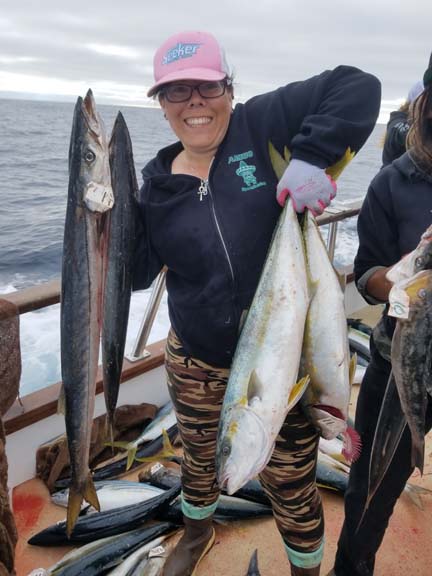 We headed to the Coronado Islands to catch some yellowtail and anything else that would bite. The Voyager arrived at 4:30am and several ladies got up to fish. They were calico fishing and it was off the hook. Every cast they caught a fish. “Waking up with these lassies at 4:30 in the morning next to the island catching bass until sunrise was my favorite part of the trip” said Donna. Hookup Baits, various plastics and sardines were what the bass were gorging themselves on.
We headed to the Coronado Islands to catch some yellowtail and anything else that would bite. The Voyager arrived at 4:30am and several ladies got up to fish. They were calico fishing and it was off the hook. Every cast they caught a fish. “Waking up with these lassies at 4:30 in the morning next to the island catching bass until sunrise was my favorite part of the trip” said Donna. Hookup Baits, various plastics and sardines were what the bass were gorging themselves on.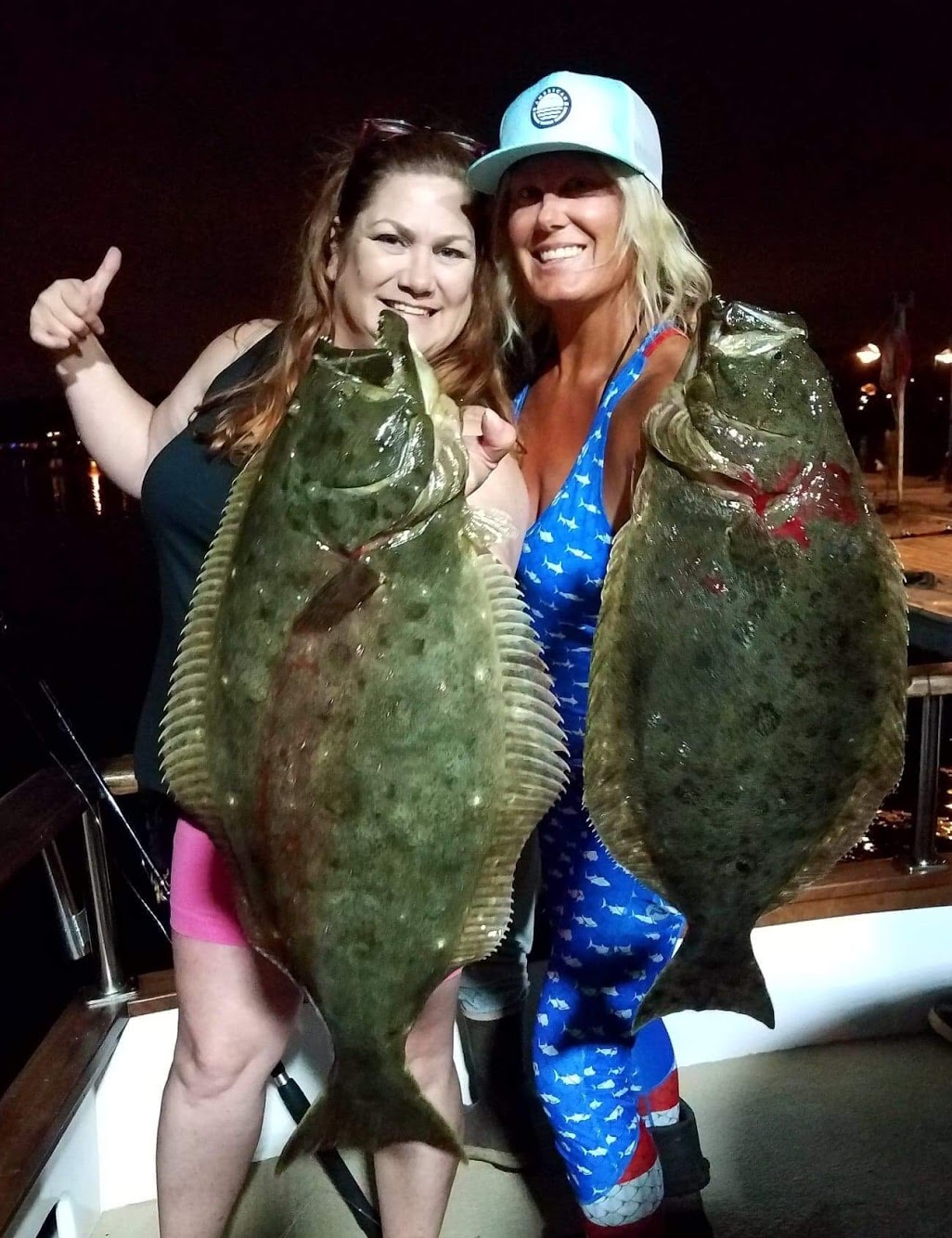 The sun rose and so did everyone who was still sleeping. Captain Todd took off to find some yellowtail. They were all around the Coronados, so they were easy to spot. The yellowtail were biting anything and everything. Charina surprisingly states, “I even caught one on a flatfall.” Sunny spent most of her day at the bow using her Seeker baby blue 9’3” rod with an Accurate Valiant 500 using a blue and white JRI jig to catch the majority of her fish. It was an incredible site to watch the yellowtail follow your lure as you reeled it in. As Casey puts it, “When everyone was hooked up on a yellowtail, the excitement was roaring.” Women have a tendency to scream when they’re hooked up to a fish. I know I do. Michelle puts it nicely, “It was a reunion of all women who come together and work together to help one another to fish and have fun.”
The sun rose and so did everyone who was still sleeping. Captain Todd took off to find some yellowtail. They were all around the Coronados, so they were easy to spot. The yellowtail were biting anything and everything. Charina surprisingly states, “I even caught one on a flatfall.” Sunny spent most of her day at the bow using her Seeker baby blue 9’3” rod with an Accurate Valiant 500 using a blue and white JRI jig to catch the majority of her fish. It was an incredible site to watch the yellowtail follow your lure as you reeled it in. As Casey puts it, “When everyone was hooked up on a yellowtail, the excitement was roaring.” Women have a tendency to scream when they’re hooked up to a fish. I know I do. Michelle puts it nicely, “It was a reunion of all women who come together and work together to help one another to fish and have fun.”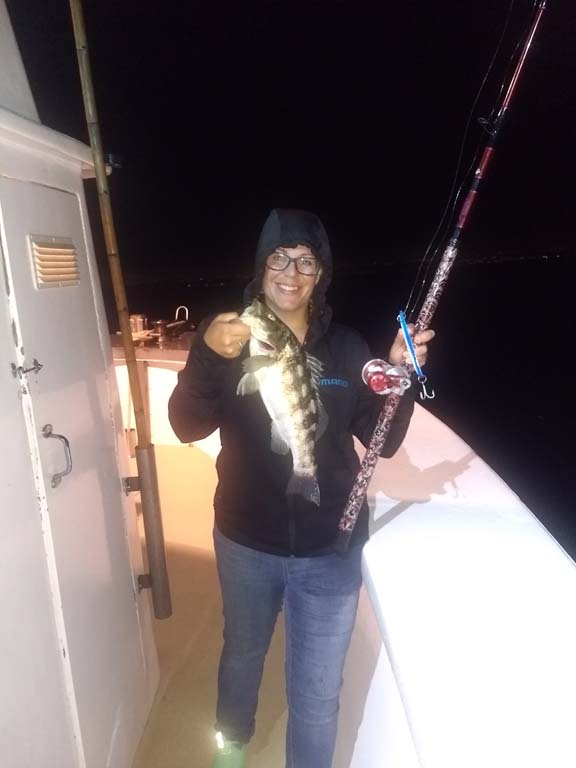 My first fish was a huge bonito caught on my Accurate Valiant 300 using sardines. I’m the kind of angler who tries everything just for fun when fishing because you never know what the fish will bite. I tried a surface iron and almost landed the fish except it spit the hook. Using a yoyo setup wasn’t a good choice. The fish didn’t bite it at all. The hot ticket seemed to be the live bait which were sardines and that was what I landed my jackpot fish on. I caught all my yellowtail on them as did most of the other ladies.
My first fish was a huge bonito caught on my Accurate Valiant 300 using sardines. I’m the kind of angler who tries everything just for fun when fishing because you never know what the fish will bite. I tried a surface iron and almost landed the fish except it spit the hook. Using a yoyo setup wasn’t a good choice. The fish didn’t bite it at all. The hot ticket seemed to be the live bait which were sardines and that was what I landed my jackpot fish on. I caught all my yellowtail on them as did most of the other ladies.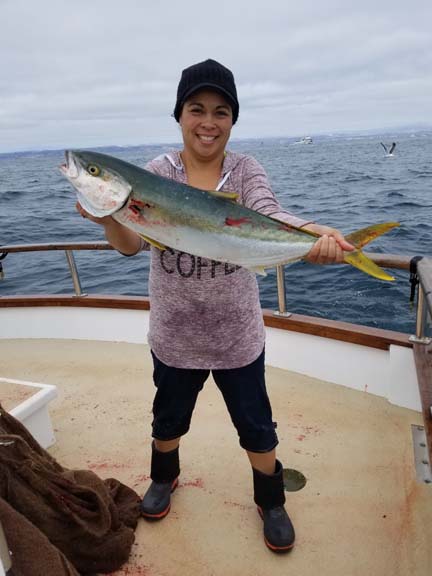 The sea lions were in full force as we fished. Jessica was hooked up with one of her many yellowtails and wouldn’t you know it, a seal lion tried to get it away from her. She fought hard for that fish and won. Jessica exclaimed, “When I got the yellowtail on the boat, there were no bite marks on it.” I didn’t get as lucky. The fish was at the boat with color and the deckhand tried to gaff it twice, but he missed both times. Out from under the boat in stealth mode, came a seal that must have been about 800lbs. He was the biggest one I think I’ve ever seen. He stole my fish and next thing you know my line is ripping off my reel. I stared at the deckhand in disbelief as I watched my line take off. The funny part is, I got all my line back and even the sliding sinker was there. The only thing missing was the hook. I hope it caused some pain to the seal’s stomach when he ate my fish.
The sea lions were in full force as we fished. Jessica was hooked up with one of her many yellowtails and wouldn’t you know it, a seal lion tried to get it away from her. She fought hard for that fish and won. Jessica exclaimed, “When I got the yellowtail on the boat, there were no bite marks on it.” I didn’t get as lucky. The fish was at the boat with color and the deckhand tried to gaff it twice, but he missed both times. Out from under the boat in stealth mode, came a seal that must have been about 800lbs. He was the biggest one I think I’ve ever seen. He stole my fish and next thing you know my line is ripping off my reel. I stared at the deckhand in disbelief as I watched my line take off. The funny part is, I got all my line back and even the sliding sinker was there. The only thing missing was the hook. I hope it caused some pain to the seal’s stomach when he ate my fish.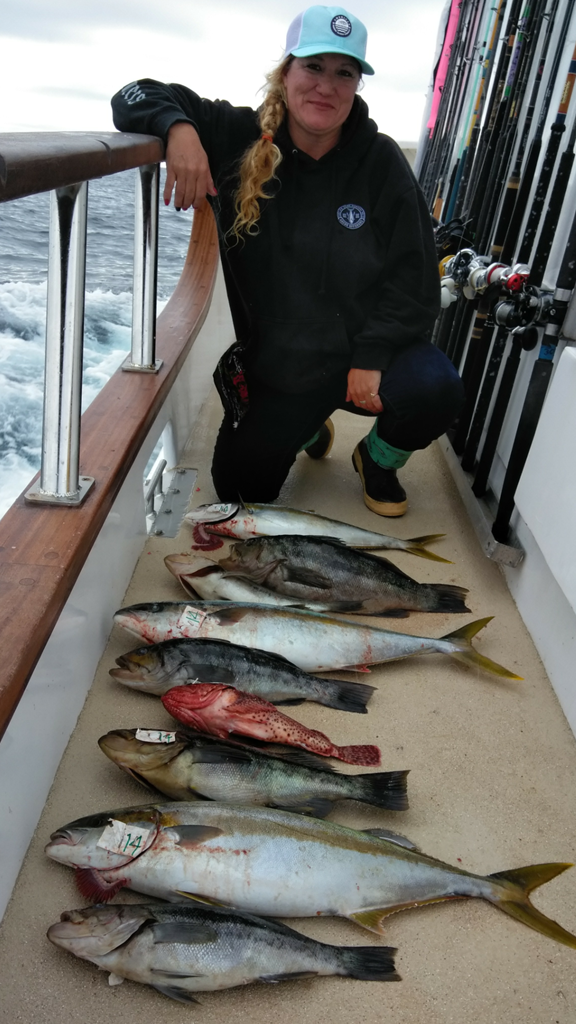 One thing about fishing with women is they encourage each other. If someone lost a fish, the others would say, “You’ll get them next time.” No one said anything negative about anyone or to anyone. We were there for each other no matter what. There were many levels of expertise on the boat, but we all did great and put the wood to the fish. “Imagine my surprise when we got on some yellowtail and all the women fished well. At one point I was fighting a fish and I looked down the rail and saw 4 women on fish weaving over and under, working together, yelling ‘color’ all over the place and successfully landing them all” said Rachel. We kept the deckhands on their toes and they definitely earned their keep that day.
One thing about fishing with women is they encourage each other. If someone lost a fish, the others would say, “You’ll get them next time.” No one said anything negative about anyone or to anyone. We were there for each other no matter what. There were many levels of expertise on the boat, but we all did great and put the wood to the fish. “Imagine my surprise when we got on some yellowtail and all the women fished well. At one point I was fighting a fish and I looked down the rail and saw 4 women on fish weaving over and under, working together, yelling ‘color’ all over the place and successfully landing them all” said Rachel. We kept the deckhands on their toes and they definitely earned their keep that day.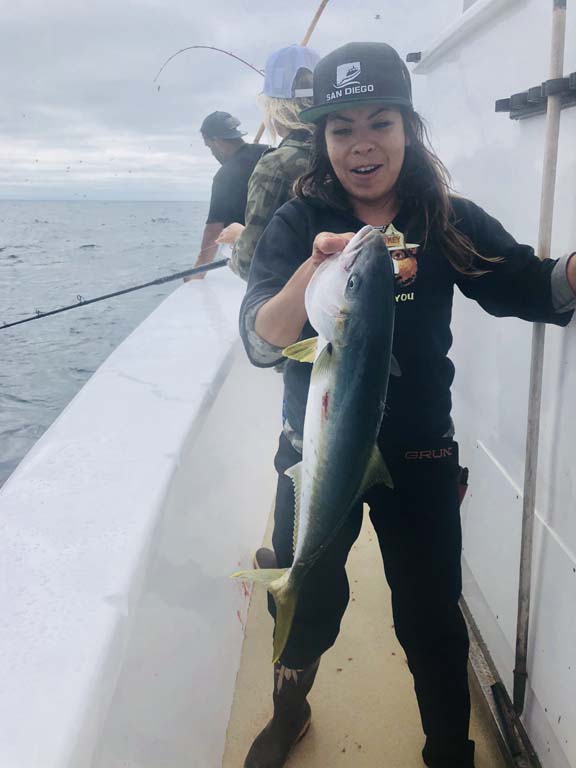 A funny thing happened to Ginger on the trip. She was fishing on the bow when she felt something poking her toe. She took off her boot, but didn’t see anything. She put it back on and the pain was even worse, then suddenly she saw a fish spine broken off in the top of her boot. At that exact moment, she landed a yellowtail. She threw her boot off and started winding it in on one foot while the deckhand worked to get the spine out. The deckhand got the boot back on her foot just in time for him to gaff her fish and this just happened to be the first yellowtail she ever caught.
A funny thing happened to Ginger on the trip. She was fishing on the bow when she felt something poking her toe. She took off her boot, but didn’t see anything. She put it back on and the pain was even worse, then suddenly she saw a fish spine broken off in the top of her boot. At that exact moment, she landed a yellowtail. She threw her boot off and started winding it in on one foot while the deckhand worked to get the spine out. The deckhand got the boot back on her foot just in time for him to gaff her fish and this just happened to be the first yellowtail she ever caught.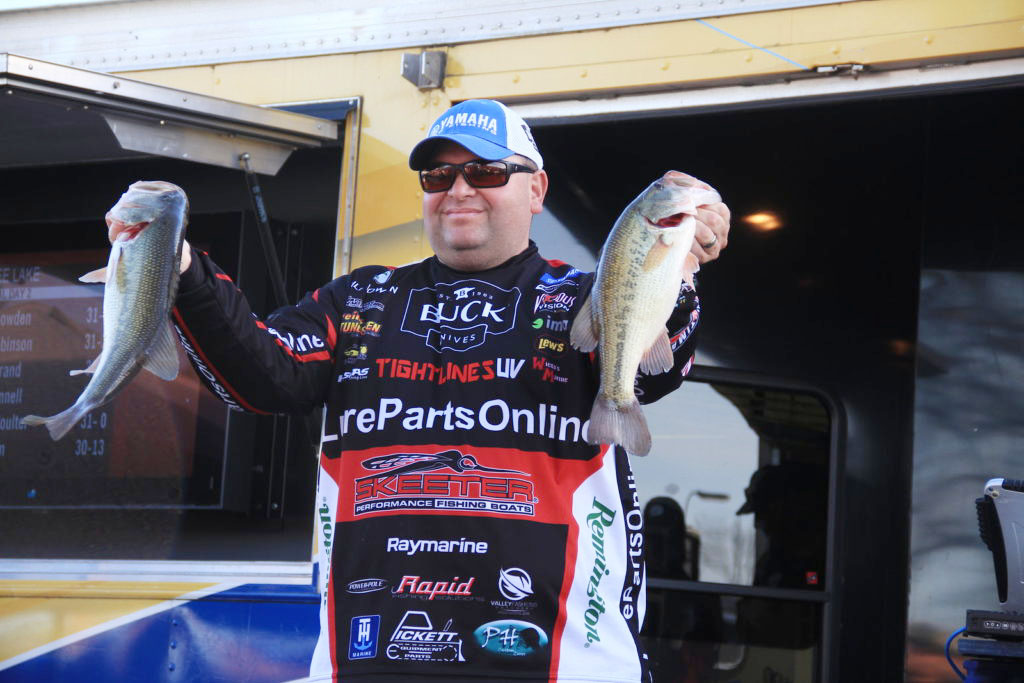
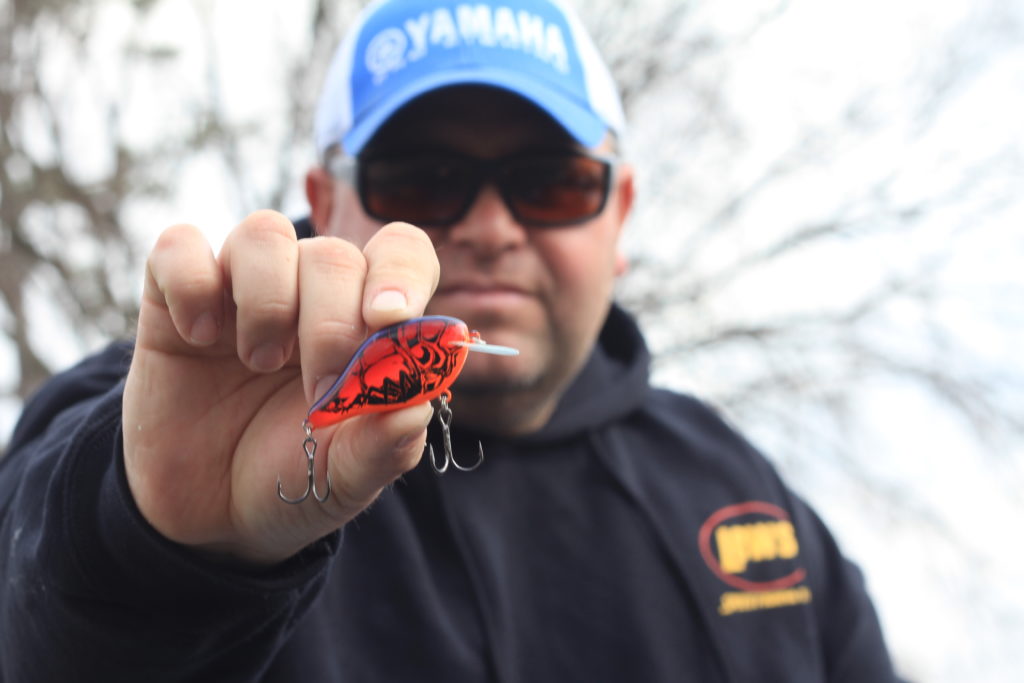 Water Clarity
Water Clarity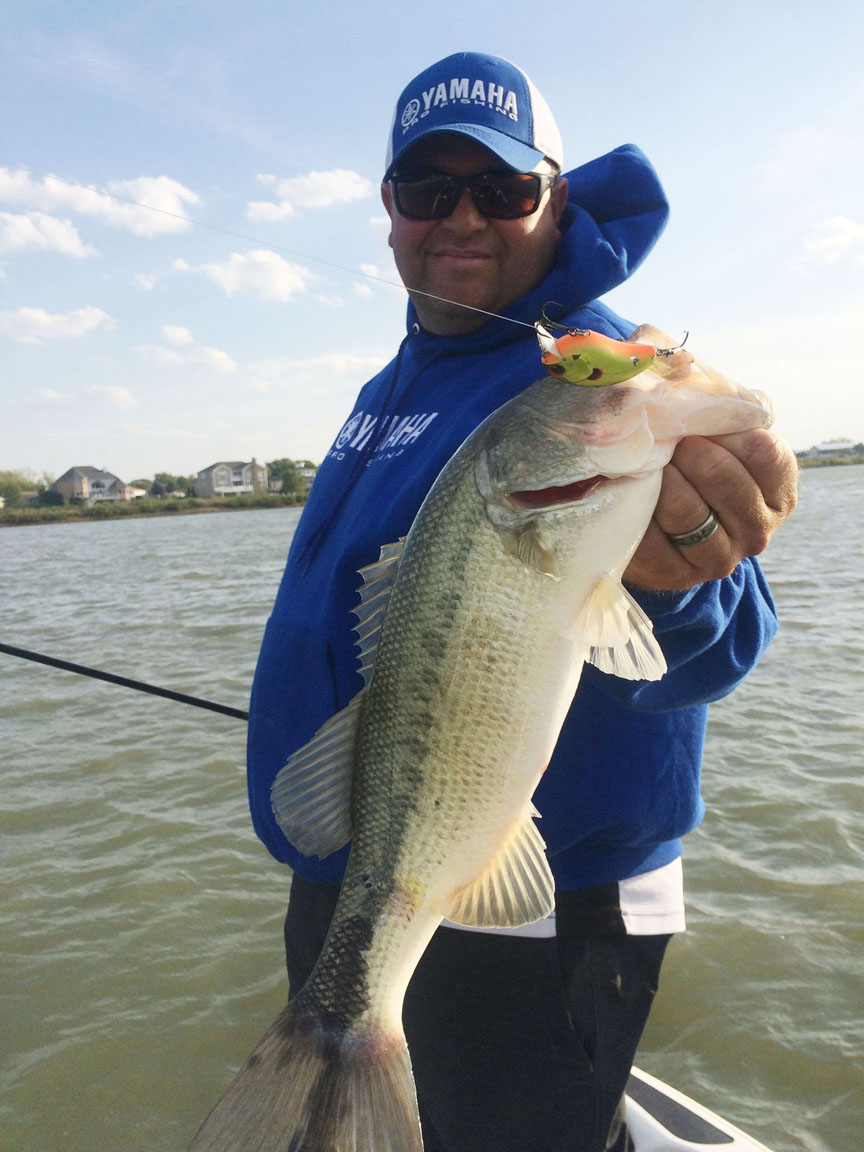 Time of Year
Time of Year
 That night, most of us got our gear ready for the morning while the boat got bait and began it’s journey to San Clemente. Ricardo Zepeda always helps me to set my drag and get my tackle together, so in the morning I don’t have to worry about it. Captain Andrew Viola was the night driver and drove us to the island safely.
That night, most of us got our gear ready for the morning while the boat got bait and began it’s journey to San Clemente. Ricardo Zepeda always helps me to set my drag and get my tackle together, so in the morning I don’t have to worry about it. Captain Andrew Viola was the night driver and drove us to the island safely. Oscar Ochoa was the hot stick on this trip. Every time I turned around, he was on a fish. He caught about 7 yellowtail and a variety of other fish. He could do no wrong. Joseph Wilson caught 3 yellows, and Brian Kelly, one of the deckhands, passed a yellowtail he hooked to Sydney Deturk. Watching her face while the fish was fighting was an awesome sight. Unfortunately, the fish won, but that happens. On her own, she managed to get a few bass. Another lady angler, hooked up to a yellowtail and it took her all the way around the boat. We all cheered her on as she reeled it in. All 3 ladies had a fish under their belt. Girl Power.
Oscar Ochoa was the hot stick on this trip. Every time I turned around, he was on a fish. He caught about 7 yellowtail and a variety of other fish. He could do no wrong. Joseph Wilson caught 3 yellows, and Brian Kelly, one of the deckhands, passed a yellowtail he hooked to Sydney Deturk. Watching her face while the fish was fighting was an awesome sight. Unfortunately, the fish won, but that happens. On her own, she managed to get a few bass. Another lady angler, hooked up to a yellowtail and it took her all the way around the boat. We all cheered her on as she reeled it in. All 3 ladies had a fish under their belt. Girl Power. Our bait choices were either sardine or squid. I hate picking up squid. Their tentacles give me the creeps. Ricardo always laughs at me as I attempt to grab one and drop it when it tries to grab me. Sometimes I get it on the hook and other times he hooks it on for me. I guess that’s one of the perks of being a female. Putting on a sardine is as easy as pie. It’s those crazy squid that get me.
Our bait choices were either sardine or squid. I hate picking up squid. Their tentacles give me the creeps. Ricardo always laughs at me as I attempt to grab one and drop it when it tries to grab me. Sometimes I get it on the hook and other times he hooks it on for me. I guess that’s one of the perks of being a female. Putting on a sardine is as easy as pie. It’s those crazy squid that get me. We drove around San Clemente looking for fish and we stopped several times. One time, we found some bass. George Schewardz hooked up to a beautiful calico that gave him quite a fight. It was definitely a keeper. I caught a couple bass on a Hookup Bait, but none were as big as George’s.
We drove around San Clemente looking for fish and we stopped several times. One time, we found some bass. George Schewardz hooked up to a beautiful calico that gave him quite a fight. It was definitely a keeper. I caught a couple bass on a Hookup Bait, but none were as big as George’s. The trip was a success and everyone was happy with their catch. The crew always gives 100% and helps other anglers when they need it. I am pleased to say I won jackpot with my 32lb. yellowtail caught on a Moon’s custom rod 7.5 ft. Super Seeker with an Accurate Boss Xtreme 400 loaded with 65lb. spectra and 40lb. mono. Having a passion for a male dominated sport has never deterred me when it comes to fishing. I think other ladies should try it out. They might find that they love it as much as I do, and I would be willing to help them out anyway I can. Tails up!
The trip was a success and everyone was happy with their catch. The crew always gives 100% and helps other anglers when they need it. I am pleased to say I won jackpot with my 32lb. yellowtail caught on a Moon’s custom rod 7.5 ft. Super Seeker with an Accurate Boss Xtreme 400 loaded with 65lb. spectra and 40lb. mono. Having a passion for a male dominated sport has never deterred me when it comes to fishing. I think other ladies should try it out. They might find that they love it as much as I do, and I would be willing to help them out anyway I can. Tails up!